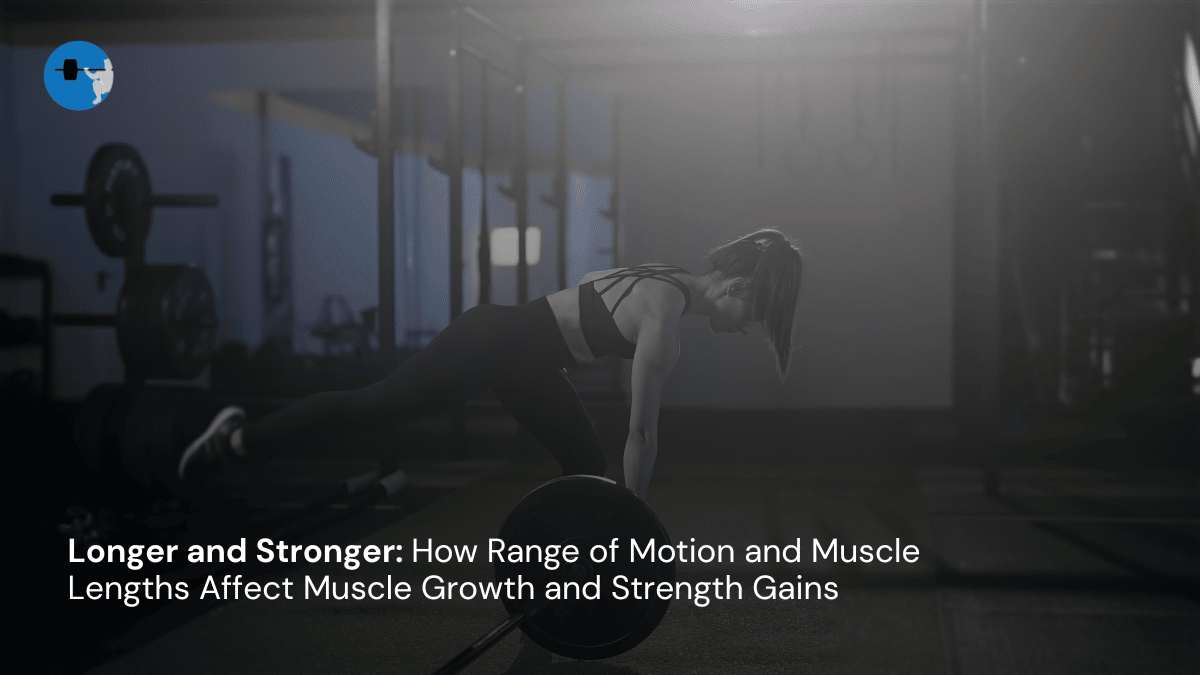Note: This article was the MASS Research Review cover story for November 2022. If you want more content like this, subscribe to MASS.
When you walk into a commercial gym, you’ll see folks executing reps with every technique under the sun. Some people lift every rep explosively, and other folks move the bar at a snail’s pace. Some folks pause and squeeze at the bottom and top of each rep, and other folks treat biceps curls as if they’re plyometrics. And, notably for our purposes here, some folks move every rep through a maximal range of motion, while other folks stick to partial reps.
When it comes to range of motion, who has it right? Do you need to train through a full range of motion? Are you leaving gains on the table when you do partial reps? If you do partials, does it matter what kind of partial reps you do?
This article will attempt to answer all of these questions and more.
Sports science is experiencing a bit of a renaissance around the topic of range of motion. Almost half of the research examining the impact of range of motion on strength gains and/or muscle growth was published within the past five years, and nearly all of it was published within the past decade. So, we’re finally reaching the point where we can start providing relatively solid answers about the impact of range of motion on strength and hypertrophy adaptations, with a reasonable degree of detail and nuance.
With that in mind, my (Milo’s) coauthors and I recently completed a meta-analysis examining the effects of range of motion on strength, hypertrophy, power, body composition, and sport performance outcomes (1). We started with a systematic literature search to identify all of the studies meeting these three criteria:
- The study needed to be a full-text peer-reviewed study, or a graduate-level thesis or dissertation available in English.
- The study needed to include a longitudinal training intervention with at least two groups or conditions that involved training through differing ranges of motion.
- The study needed to report at least one outcome related to strength, hypertrophy, power, body composition, or sport performance, with sufficient detail for statistical analysis.
Ultimately, 23 studies met these criteria and were included in our meta-analysis. Outcome data were extracted from each study, and effect sizes were calculated as Hedges’ g values, which are interpreted similarly to Cohen’s d values.
Our first set of analyses were “big picture” analyses. We wanted to see, in general, whether training through a full range of motion produces larger beneficial outcomes than training through a partial range of motion. We found that, when pooling all outcomes from all studies together, training through a full range of motion was generally preferable to training through a partial range of motion, though the overall difference between full and partial range of motion training was trivial in magnitude (g = 0.12; Figure 1).
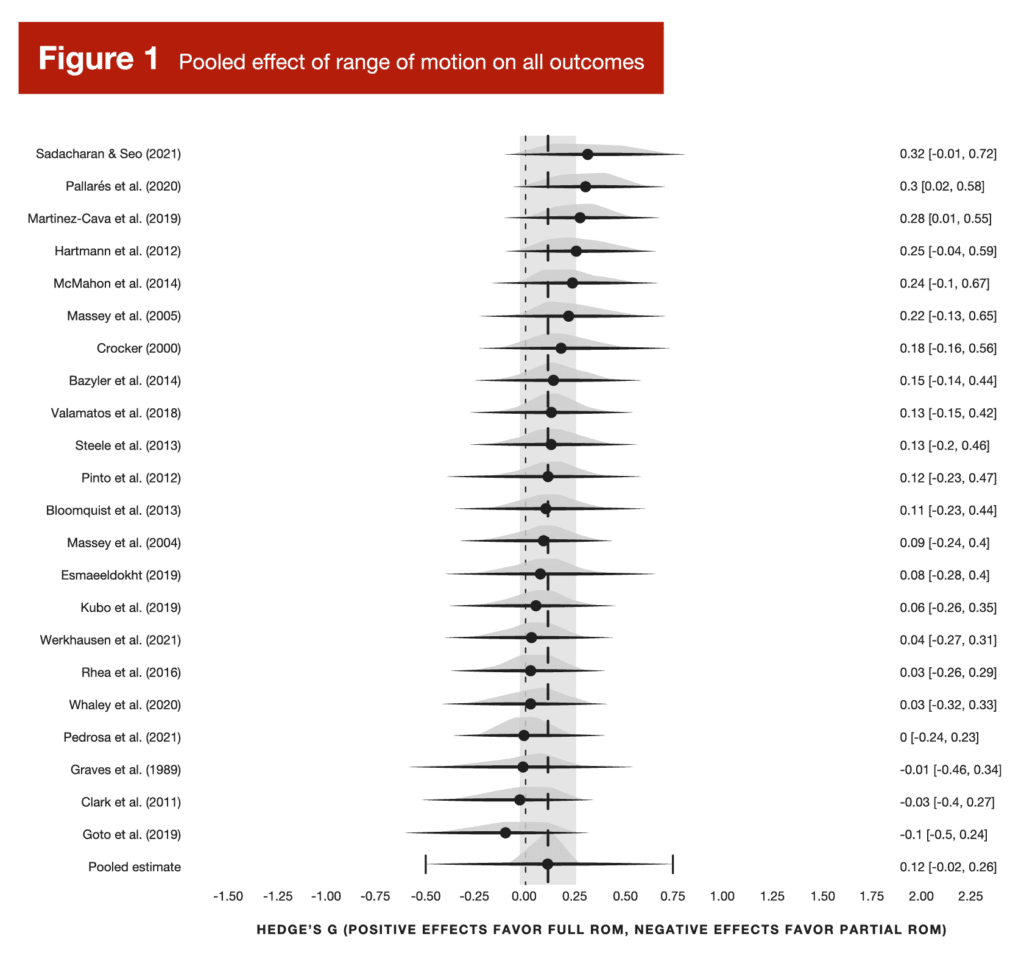
When separating different outcomes (strength, hypertrophy, power, body composition, and sport performance), a similar picture emerges: training through a full range of motion generally produces larger adaptations than training through a partial range of motion, but the pooled effects are, once again, trivial in magnitude (Figure 2).
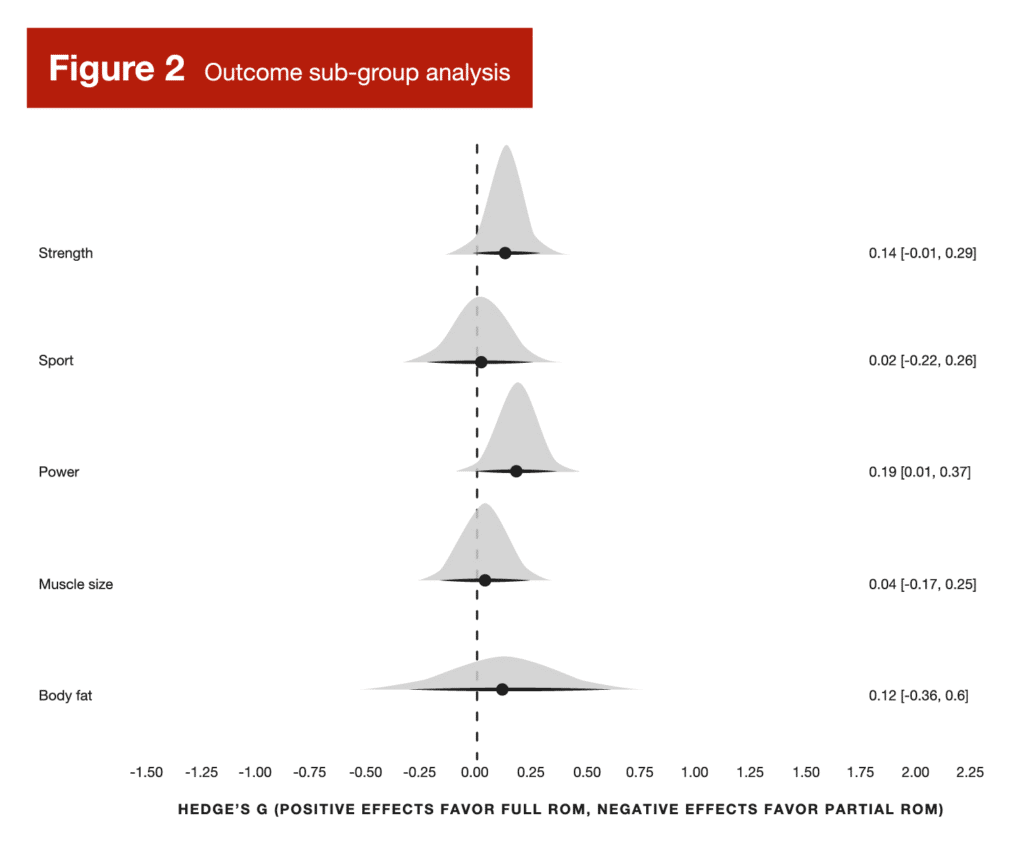
At this point, you may be underwhelmed. If range of motion only has a trivial impact on most adaptations, why worry about it in the first place?
As mentioned previously, this is a surprisingly nuanced subject. When we go one step deeper, the more interesting details begin to emerge.
Let’s start by looking at a secondary analysis of strength adaptations. We wanted to see whether the exercise used for testing strength influenced whether full or partial range of motion training proved superior for strength development. In other words, a study might have one group of subjects training half squats for three months and one group of subjects training full squats for three months. Before the start of the training intervention and at the end of the training intervention, all subjects in both groups test their 1RM half squat strength, 1RM full squat strength, and maximal isometric knee extension torque. In this scenario, the 1RM half squat is a test of strength biased in favor of the group training through a partial range of motion – the subjects in the half squat group performed a lot of half squats during the training intervention, so they should be more skilled half squatters by the end of the study than the subjects in the full squat group. Conversely, the 1RM full squat is a test of strength biased in favor of the full squat group. Finally, the test of maximal isometric knee extension torque is an unbiased strength test – neither group was specifically “training for the test.”
Unsurprisingly, we found that full range of motion training produced larger strength gains in strength tests biased in favor of full range of motion training. Conversely, partial range of motion training produced larger strength gains in strength tests biased in favor of partial range of motion training. However, partial range of motion training was only trivially better than full range of motion training (g = 0.11) for increasing partial range of motion strength, whereas full range of motion training was quite a bit more effective than partial range of motion training (g = 0.34) for increasing full range of motion strength. Finally, both full and partial range of motion training seemed to be similarly effective for increasing strength in unbiased strength tests (Figure 3).
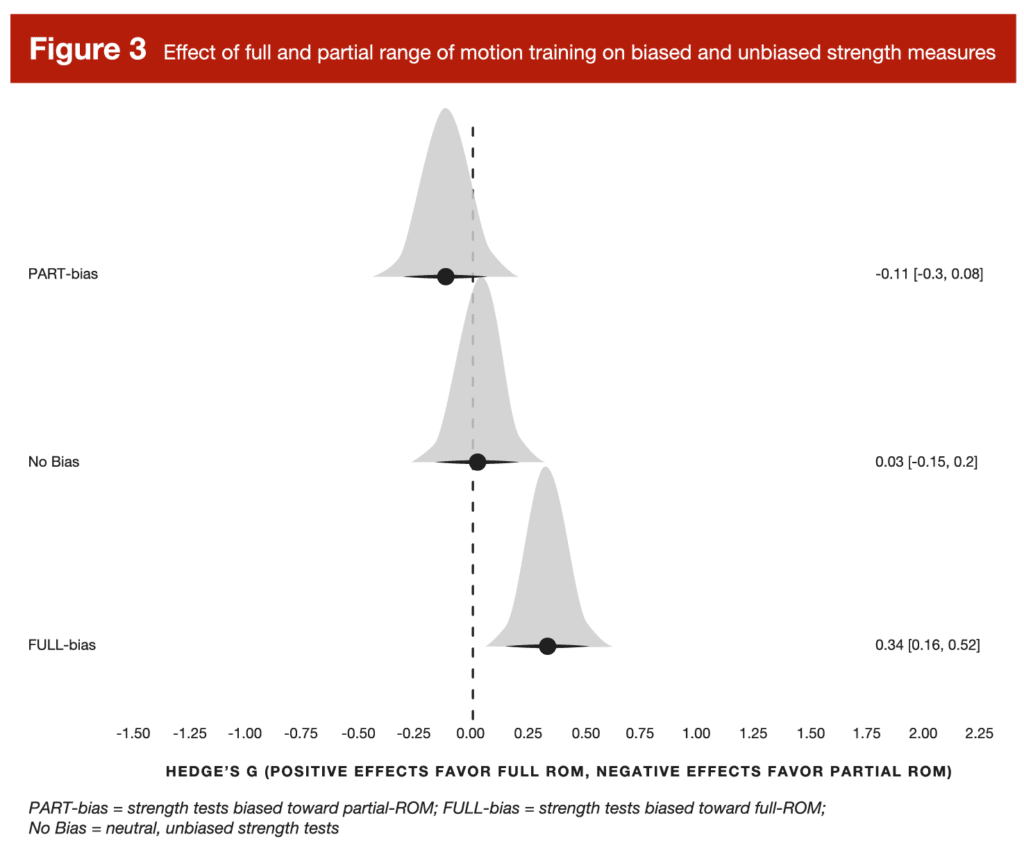
In other words, full squat training might increase your full squat 1RM by 20% and your half squat 1RM by 15%, whereas half squat training might increase your half squat strength 1RM 20%, but only increase your full squat 1RM by 10%.
Overall, this should be a pretty intuitive finding. After all, the entire half squat range of motion is included within the full squat range of motion, so if you’re doing full squats, you are still training your knee and hip extensors through the joint angles associated with half squatting. So, it makes sense that improving your full range of motion strength is pretty effective at improving your partial range of motion strength. However, when you do partial range of motion training, there’s simply a range of muscle lengths and joint angles you aren’t stressing with each rep, thus making partial range of motion training considerably less effective at promoting gains in full range of motion training in most contexts.
Moving onto a secondary analysis of hypertrophy results, it’s worth asking whether it matters what type of partial range of motion training you do. After all, in most comparisons of full versus partial range of motion training, there isn’t just one difference between training protocols (range of motion). There are two differences: the total range of motion you train through, and the muscle lengths being trained. So, it’s worth considering which of those variables has the largest impact.
When people think about partial range of motion training, they generally think about partials that train the target muscle(s) through short muscle lengths. Examples include standard half squats and standard half-reps on bench press. With standard half squats, the muscle fibers of the quads don’t have to stretch very far at the bottom of each rep; with standard half-reps on bench press, the muscle fibers of the pecs and triceps don’t have to stretch very far at the bottom of each rep. So, these exercises only train the prime movers through short muscle lengths.
Conversely, you could also perform the opposite, less common form of partial range of motion training: partial range of motion training through long muscle lengths. For example, you could do half squats where you only perform the bottom half of each rep – starting the concentric phase at the very bottom of a deep squat, with the “top” of each rep being the typical “bottom” position for a standard half squat. Similarly, instead of half-repping bench press reps by not touching the bar to your chest, you could do half reps that involve starting with the bar on your chest, and only pressing the bar until it’s halfway to a “locked out” position. In both of these examples, instead of training the prime movers through short muscle lengths and neglecting long muscle lengths, you’re training the prime movers through long muscle lengths and neglecting short muscle lengths.
If range of motion is the most important variable for muscle growth, then training through a full range of motion should produce more muscle growth than training through a partial range of motion regardless of the muscle lengths being trained by the partials. However, if muscle length is the important variable, then we should expect partials through short muscle lengths and partials through long muscle lengths to produce different hypertrophy results.
Our analysis suggests that muscle lengths matter more than range of motion per se. Full range of motion training produced slightly more muscle growth than partials through short muscle lengths, whereas partials through long muscle lengths generally produced more muscle growth than full range of motion training (Figure 4).
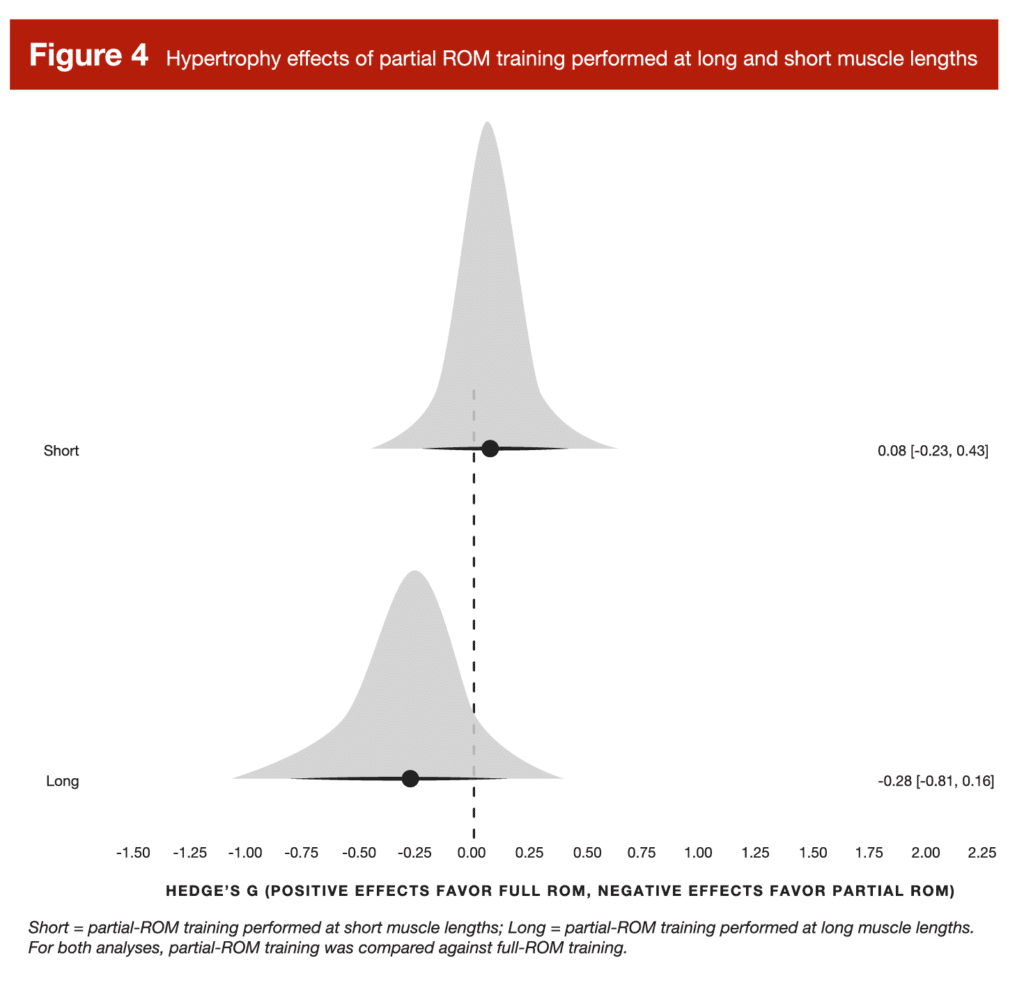
Furthermore, it appears that training through longer muscle lengths specifically leads to more hypertrophy in more distal regions of muscles. For example, comparing the effects of full squats and half squats (through the top half of the range of motion), full squats will likely lead to slightly more muscle growth in the regions of the quads that are closer to the hips, but considerably more muscle growth in the regions of the quads that are closer to the knees. We didn’t specifically meta-analyze this precise consideration, but Table 1 and Figure 5 summarize the research investigating the impact of training at longer versus shorter muscle lengths on regional hypertrophy responses.
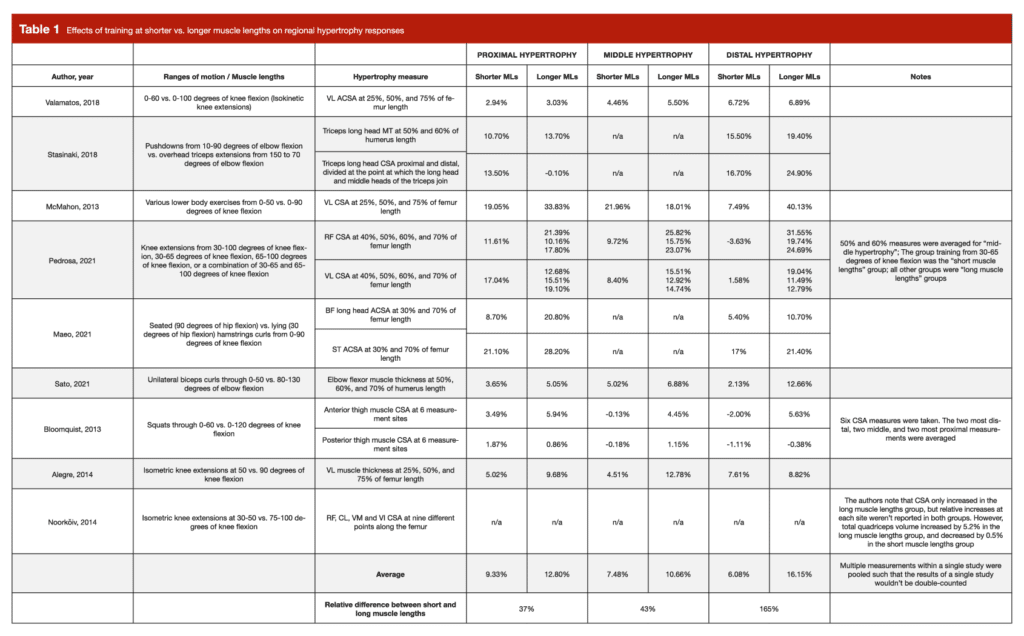
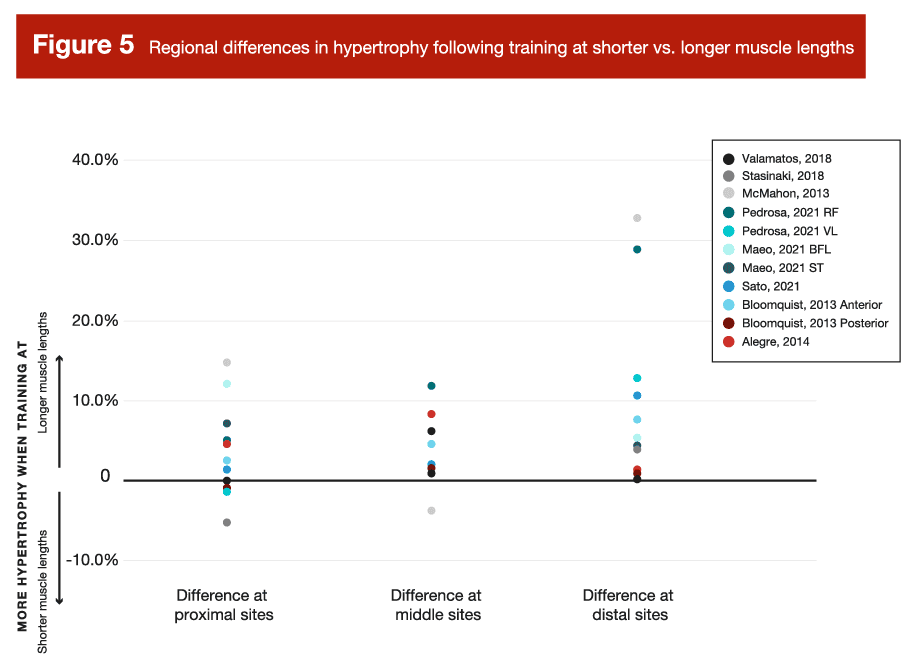
Further Nuance for Strength and Performance
Ultimately, meta-analytic data can only take us so far – it can tell us, in broad strokes, what general factors tend to influence particular outcomes, but there’s often considerable nuance lurking beneath the surface.
Before discussing some studies that shed further light on the influence of range of motion on strength and performance, it’s worth taking a step back to discuss a few reasons why range of motion should impact specific strength and performance outcomes.
Potential Mechanisms
First, training through a longer range of motion (or training through longer muscle lengths) seems to lead to more hypertrophy. Therefore, since hypertrophy contributes to strength development, you should expect that training through a longer range of motion will eventually lead to larger strength gains. After all, muscle size reflects the number of contractile proteins in parallel within a muscle – if you have more parallel contractile units, your muscles should be able to contract with more force, all else being equal (2). However, the current research presented in this meta-analysis suggests that differences in hypertrophy probably aren’t a major factor contributing to the aggregated strength and performance results in the extant research. Unbiased measurements of muscle strength tend to find that full-ROM training and partial-ROM training are similarly effective for strength development. And, when taking a step back, that makes a lot of sense. During the early phases of training, gains in muscle mass are only minimally predictive of changes in strength (3); early strength gains seem to be much more strongly influenced by neural adaptations. So, it’s possible that training at longer muscle lengths or through longer ranges of motion would eventually result in larger strength gains due to their ability to promote greater hypertrophy, but such an effect may not be detectable within the time frame of a typical resistance training study (i.e. over a span of weeks-to-months).
Second, the range of motion you train through likely influences the specific motor skills you’ll hone. If you consistently do full squats, you’ll become more skillful at doing full squats. If you consistently do half squats, you’ll become more skillful at doing half squats. This is a very simple point, but it likely explains most of the strength-related findings in the meta-analysis. Partial-ROM training tended to lead to larger strength gains in partial-ROM strength tests, and full-ROM training tended to lead to larger strength gains in full-ROM strength tests.
Third, resistance training with an eccentric component (i.e., most resistance training) can shift the length-tension relationship of muscles, and therefore affect the optimal joint angle for force output (4; Figure 6). For instance, your quads may be able to generate the most knee extension torque at 60° of knee flexion pre-training. However, after a few months of deep squatting, your quads may generate peak levels of torque at 75° of knee flexion. Since the hardest part of the squat occurs when the knees are quite flexed, this shift toward greater force production at longer muscle lengths would tend to independently increase deep squat performance. This could, in part, explain the meta-analysis’s findings related to biased strength tests. In other words, it could help explain why full-ROM training was considerably better than partial-ROM training for improving full-ROM strength, but partial-ROM training was only slightly better than full-ROM training for improving partial-ROM strength.
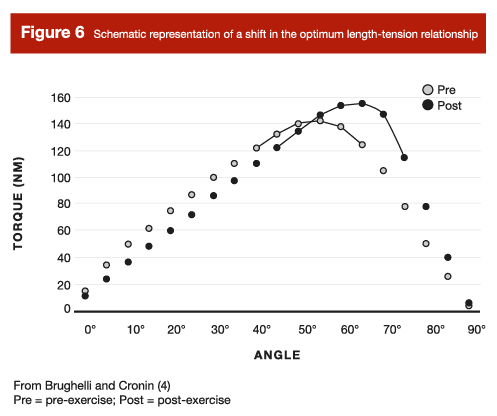
Potential Impacts of Training Status
A particular pair of very similar studies with very different results warrant a closer look.
A 2013 study by Bloomquist and colleagues had one group of subjects train deep squats (through 120° of knee flexion) and one group train shallow squats (though 60° of knee flexion) for 12 weeks (5). Squat jump and countermovement jump performance were assessed pre- and post-training. Deep squats led to larger improvements in jump performance than shallow squats (Figure 7).
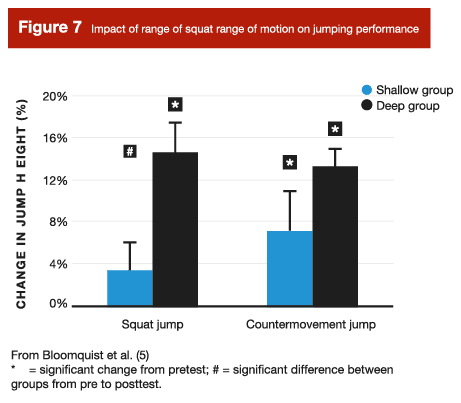
A 2016 study by Rhea and colleagues had one group of subjects train full squats (through at least 110° of knee flexion), one group of subjects train half squats (through 85-95° of knee flexion), and one group of subjects train quarter squats (through 55-65° of knee flexion) for 16 weeks (6). Vertical jump performance was assessed pre- and post-training. Half squats and quarter squats led to larger improvements in jump performance than full squats (Figure 8).
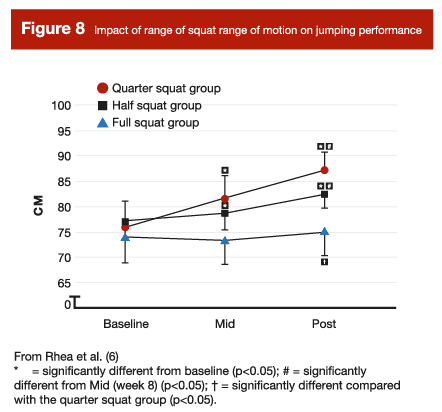
The biggest differences between these two studies were the characteristics of the subjects. The Bloomquist study was performed on effectively untrained subjects. To quote the authors: “If [the subjects] had been squat training more than once weekly during the preceding 6 months, or if they were engaged in strength or power sports, they were excluded from the study.” On the other hand, the Rhea study was performed on collegiate athletes with at least two years of prior training experience, and a 1RM squat of at least 1.5-times body mass.
At least in a vacuum, one should anticipate that partial squats would be more effective for promoting gains in jump height, because the joint angles of a vertical jump more closely mimic the joint angles of a partial squat – not many people drop into a full squat position when attempting to jump as high as possible. As such, these findings suggest that novice lifters derive general benefits from full-ROM training that trump even the principle of specificity. In high-level athletes, on the other hand, the principle of specificity won out, as quarter squats (more closely mimicking the joint angles of jumping) produced larger gains in jump performance.
In fact, a 2019 study by Martínez-Cava and colleagues further bolsters this point (7; MASS Review). Three groups of young men completed a 10-week bench press training intervention through different ranges of motion. One group performed full-ROM bench press reps (touching the bar to their chest at the bottom of each rep, and locking out their elbows at the top of each rep), one group performed 2/3rds-ROM reps at short muscle lengths (locking their elbows at the top of each rep, but only bringing the bar down 2/3rds of the way to their chest), and one group performed 1/3rd-ROM reps at short muscle lengths (only bringing the bar down 1/3rd of the way to their chest). Full-ROM, 2/3rd-ROM, and 1/3rd-ROM bench press 1RM were assessed pre- and post-training. Subjects in this study weren’t completely untrained, but they also weren’t particularly well-trained – they were only required to have six months of prior training experience, and the average bench press 1RM was less than the average body mass of the subjects (71.8kg at a body mass of 73.4kg).
In keeping with the principle of specificity – and the results of the present meta-analysis (1) – you should expect the full-ROM group to experience the largest gains in full-ROM bench press strength, the 2/3rd-ROM group to experience the largest gains in 2/3rd-ROM bench press strength, and the 1/3rd-ROM group to experience the largest gains in 1/3rd-ROM bench press strength. However, that’s not what the researchers observed. Instead, the full-ROM group experienced larger strength gains than the other two groups through all three ranges of motion (Figure 9).

While there’s not research to back up this point, this finding runs counter to the experiences of high-level bench pressers. Really strong bench pressers who want to build strength through the top part of the bench press range of motion (to maximize equipped bench press performance, for example) routinely turn to partial-ROM board presses or pin presses to build lockout strength. It’s certainly possible that they’re all wasting their time, but that seems very unlikely. Raw lifters who don’t do much partial-ROM training might find that their full-ROM 1RM is only a little lower than their partial-ROM 1RM (a two-board or three-board press, for example). However, equipped powerlifters who regularly perform a lot of partial-ROM training might be able to use >20% more weight for a partial-ROM bench press than a full-ROM bench press. It certainly seems that, for these high-level benchers, a heavy diet of partial-ROM training yields ROM-specific strength gains through a partial range of motion.
Finally, a study by Pallarés and colleagues (58) obtained results that largely mirrored the results of the Martínez-Cava study. The male subjects in this study had some degree of prior squatting experience, but they weren’t particularly well-trained – pretraining, their average 1RM full squat was just 87.3kg, at an average body mass of 76kg. Subjects trained either half squats, parallel squats, or full squats for 10 weeks. The group training full squats achieved the largest nominal gains in full squat, parallel squat, and half squat 1RM, and also experienced the largest improvements in Wingate test, 20m sprint, and countermovement jump performance.
Thus, there’s at least some indication that, while gains in strength and performance tend to be ROM-specific, the training status of the lifter might also be relevant. Namely, training through a full range of motion may be generally preferable for less experienced lifters, even when aiming to improve performance through a partial range of motion. However, the principle of specificity seems to be a more reliable guide for more experienced lifters – if you’re aiming to increase strength and performance through a partial range of motion, then partial-ROM training seems to provide you with the biggest return on investment.
The reason for this divergence isn’t entirely clear. It’s possible that the partial-ROM strength and performance improvements following full-ROM training in less experienced lifters are simply downstream of hypertrophy – if lifters haven’t established an adequate base of muscularity to build upon, simply building more muscle pays the largest dividends. It’s also possible that eccentric stress through a longer range of motion aids in connective tissue adaptations that are conducive for force transfer to the tendons (8, 9). Ultimately, more research is needed to fully explain (or potentially refute) these tentative observations.
Combining Ranges of Motion for Performance
Before wrapping up this discussion of the impact of range of motion on strength and performance, it’s worth noting that you don’t have to choose between exclusively doing full-ROM training or exclusively doing partial-ROM training. In fact, that’s at least some indication that combining different ranges of motion may produce synergistic (not just additive) effects.
To illustrate, here’s how it may look if a combination of full-ROM and partial-ROM training produced additive effects. Imagine that eight weeks of deep squat training, with six sets of deep squats per workout, increases full-ROM squat strength by 10%, but eight weeks of half squat training, with six sets of half squat training per workout, only increases full-ROM squat strength by 2%. If the effects of combining ranges of motion were purely additive, we might expect three sets of full squats and three sets of half squats to lead to a 6% [(10% + 2%) ÷ 2] increase in full-ROM squat strength.
However, if a combination of full-ROM and partial-ROM training produced synergistic effects, we might instead observe that a combination of full squats and half squats lead to larger strength gains than performing only full squats (even if the addition of half squats comes at the expense of full squat sets), even though full squats produce larger gains in full squat strength than half squats produce in isolation.
We don’t have many studies examining the strength and performance impact of combining ranges of motion, but the studies that do exist paint a cautiously optimistic picture.
For example, in a 2014 study by Bazyler and colleagues (10), one group of subjects performed six sets of full-ROM squats twice per week, and one group of subjects performed three sets of full-ROM squats and three sets of partial-ROM squats (through 80° of knee flexion) twice per week. Testing was performed before and after a seven-week training intervention.
Gains in full-ROM squat strength didn’t significantly differ between groups, but they tended to be larger in the group that subbed out half of their full squats for partial squats (8.2 ± 2.1%, versus 5.1 ± 4.5%). Gains in partial squat strength tell a similar story – nominally larger gains in the group performing both full and partial squats (14.9 ± 11.8%, versus 10.2 ± 11.7%).
A recent study by Gillingham and colleagues (MASS review) had similar results (11). Two groups of collegiate wrestlers completed a six-week pre-season training program. One group only trained the deadlift with a full-ROM (with each deadlift workout consisting of two sets of deadlifts), while the other group performed one full-ROM set of deadlifts, followed by three heavy, partial-ROM sets of a single rep. The partial-ROM sets were performed in a power rack; repetitions began with the bar resting on the safety pins, which were set ~1 inch above the lifters’ kneecaps.
The group only doing full-ROM training experienced a non-significant decrease in deadlift strength (-5.3 ± 13.4kg), while the group doing both full- and partial-ROM training experienced a non-significant increase in deadlift strength (4.5 ± 12.2kg). Furthermore, only the group doing both full- and partial-ROM training significantly increased its partial-ROM 1RM (45.2 ± 18.9kg, versus 11.6 ± 23.2kg).
Furthermore, a 2021 study by Pedrosa and colleagues (MASS review) compared the effects of full-ROM knee extension training, versus a combination of different partial ranges of motion (12). In this study, full-ROM was defined as the range spanning from 30° of knee flexion (a mechanical stop kept lifters from fully extending their knees at the top of each rep) to 100° of knee flexion. There were five total groups in this study, but only two are relevant for our purposes here. One group performed all of their sets through a full range of motion. Another group performed half of their sets through just the bottom half of the range of motion (from 100° to 65° of knee flexion), and half of their sets through just the top half of the range of motion (from 65° of knee flexion to 30° of knee flexion). Full- and partial-ROM knee extension strength were assessed before and after the 12-week training intervention.
The group doing a combination of long muscle length and short muscle length partial-ROM training gained more strength than the group doing full-ROM training. The difference was statistically significant for gains in strength through the bottom of the ROM (32% vs. 16%), with non-significant differences through a full range of motion (24.1% vs. 17.5%), and through the top of the ROM (13% vs. 20%).
Finally, a 2020 study by Whaley and colleagues addressed this question from a slightly different angle (13). It compared the effects of full-ROM squat training versus progressive-ROM squat training. So, instead of varying ranges of motion within each training week, a progressive-ROM group varied ranges of motion over time. The full-ROM group trained full-ROM squats for seven weeks; the progressive-ROM group started with very partial-ROM squats in week one, and progressed toward deeper and deeper squats as the weeks progressed. Gains in 1RM full-ROM squat strength and vertical jump height didn’t significantly differ between groups, but nominal gains were larger in the progressive-ROM group (14.5 ± 9.5 versus 11.0 ± 7.6kg for squat 1RM, and 3.6 ± 4.3 versus 1.4 ± 4.3cm for vertical jump height).
When we take a step back, these four studies seem to be telling an interesting and consistent story. Even though partial-ROM training is less effective than full-ROM training for increasing full-ROM strength in a vacuum, we see that replacing some of your full-ROM training with partial-ROM training may actually lead to larger full-ROM strength gains than exclusively doing full-ROM training, at least in some contexts.
There isn’t an obvious explanation for this observation.
It could simply be a matter of improved motor learning – varied practice (practicing multiple similar, but not identical skills) tends to improve motor learning compared to only practicing one motor skill (14). For example, a study by Fonseca and colleagues found that training a variety of lower body exercises (including squats) led to larger gains in squat strength than just training squats (15); a similar principle may be at play here. If improved motor learning explains these findings, then exercise variety per se is the important factor, and training different ranges of motion is simply one avenue for adding exercise variety.
Similarly, it’s possible that overload training – performing exercises that allow you to use greater external loads than you’d be capable of moving through a full range of motion – has direct beneficial effects on strength development via some unique unexplored mechanism (for example, it’s been proposed that overload training could lead to outsized effects on connective tissue strength). Plenty of successful strength athletes swear by overload training, but there’s virtually no research examining the mechanisms by which it may have uniquely beneficial effects, so consider this a very tentative potential explanation.
Finally, it’s possible that these are just four flukey studies, and future research will fail to replicate these findings. None of these studies had particularly large sample sizes, and for comparisons of full-ROM strength gains, none of these four studies actually found statistically significant differences between groups – nominal results just leaned in favor of training through multiple ranges of motion (Table 2).
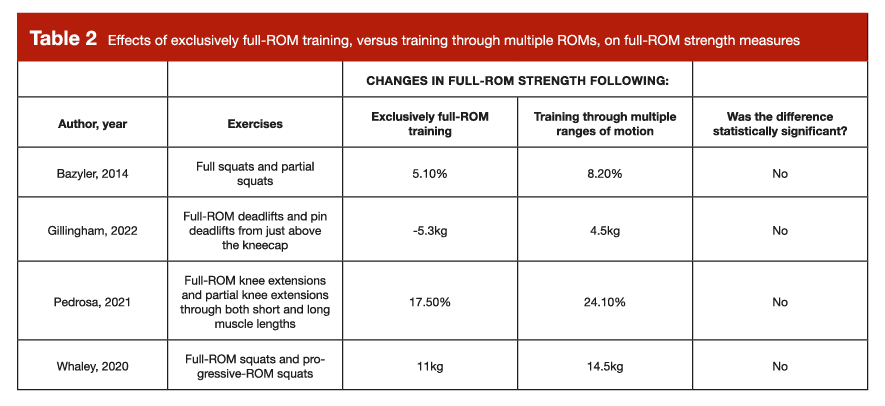
However, I don’t think this is a topic that can simply be ignored until there are a dozen studies investigating the impacts of combining full- and partial-ROM training. Most people who are interested in partial-ROM training still perform plenty of full-ROM training. So, while it’s nice to know about the effects of partial-ROM training in isolation, discussing the effects of combining full- and partial-ROM training is ultimately the more interesting and practically relevant issue. At least for now, the research suggests that replacing all of your full-ROM training with partial-ROM training (especially partial-ROM training at short muscle lengths) will lead to smaller full-ROM strength gains. But, it also tentatively suggests that replacing some of your full-ROM training with partial-ROM training may have a neutral-to-positive effect on full-ROM strength gains, at least in the short-to-medium term (over the longer term, it’s possible that doing too much partial-ROM training would result in less muscle growth, and therefore smaller strength gains).
Further Nuance for Hypertrophy
Is Range of Motion Strictly Synonymous With Muscle Length?
To this point in the article, “range of motion” and “muscle length” have been used roughly synonymously. For most exercises, if you train the first half of the typical concentric phase, you’re generally training your prime movers at long muscle lengths, and if you train the second half of the typical concentric phase, you’re generally training your prime movers at short muscle lengths.
However, when you’re training biarticular muscles (muscles that cross two joints, such as the hamstrings, the rectus femoris, and the long head of the triceps), you can alter muscle lengths without altering ranges of motion.
Using the hamstrings as an example, three heads of the hamstrings (the semitendinosus, semimembranosus, and the long head of the biceps femoris) are biarticular, because they cross both the hip and the knee. Since the hamstrings are hip extensors and knee flexors, you can lengthen the hamstrings both by flexing the hips and by extending the knees.
With this in mind, Maeo and colleagues examined the impact of seated versus lying leg curls on hamstrings hypertrophy (16; MASS Review). Employing a within-subject unilateral design, each subject trained lying leg curls (with the hips extended) with one leg, and seated leg curls (with the hips flexed) with their other leg for 12 weeks. Both exercises employed the same range of motion at the knee (the subjects trained through 90° of knee flexion), but since the hips were in a flexed position for the seated leg curls, seated leg curls still involved training hamstrings at longer muscle lengths.
The researchers observed greater hypertrophy of all three biarticular heads of the hamstrings in the legs performing seated leg curls (Figure 10).
Furthermore, both exercises involved training the short head of the biceps femoris (the only monoarticular head of the hamstrings, which only crosses the knee) at identical muscle lengths – both exercises led to similar growth in the short head of the biceps femoris. Additionally, lying leg curls trained the sartorius at longer muscle lengths (since the sartorius is a knee flexor and a hip flexor), and lying leg curls led to greater sartorius growth than seated leg curls.

Overall, this study demonstrates that muscle lengths and ranges of motion don’t always have a perfect 1:1 correspondence, and it also strongly suggests that even when equating for range of motion, training at longer muscle lengths still tends to result in more hypertrophy.
A more recent study, also by Maeo and colleagues, confirms and extends these findings (17; MASS Review). Instead of manipulating the muscle length of the hamstrings by manipulating exercise technique, the researchers manipulated the muscle length of the long head of the triceps by manipulating exercise technique. Since the long head of the triceps is both a shoulder extensor and an elbow extensor, it’s more lengthened when your arm is overhead than when it’s relaxed by your side. So, the researchers compared the effects of pushdowns (with the arms by the subjects’ sides) versus overhead triceps extensions on triceps growth.
This study also employed a within-subject unilateral design, and had subjects train through the same elbow range of motion (through 90° of elbow flexion) in both conditions. Much like the hamstrings study, this study found that overhead triceps extensions (which train the long head of the triceps at longer muscle lengths) resulted in more growth of the long head of the triceps than pushdowns, even when equating for range of motion.
However, unlike the previous study which found that both seated and lying hamstrings curls resulted in similar growth of the (monoarticular) short head of the biceps femoris, this study found that overhead triceps extensions also resulted in more growth of the monoarticular heads of the triceps. Enhanced growth of the monoarticular heads of the triceps can’t be explained by differences in the muscle lengths being trained, so there must be some other explanation for this finding. For now, just put a pin in this little mystery; we’ll circle back to it later.
When You Equate Muscle Lengths, Do You Still Benefit from Overloading the Muscle at Longer Muscle Lengths?
Since training at longer muscle lengths seems to be beneficial for hypertrophy, it’s also worth asking whether placing more tension on a muscle at longer muscle lengths is also beneficial for hypertrophy, even when equating for range of motion and muscle lengths.
To illustrate, consider the difference between a cable preacher curl and a barbell preacher curl, as shown in Figure 11. For any biceps curl, the elbow extension moment imposed by the load (and therefore the amount of elbow flexion torque your muscles need to produce to lift the load) will be at its peak when the force vector associated with the load is roughly perpendicular to the forearm. With a cable machine, that means that your biceps have to work the hardest when the cable is perpendicular to your forearm, since the resistance from the machine is being transmitted through the cable. With a barbell, the resistance is due to gravity, which pulls straight down toward the floor. So, your biceps have to produce the most force when your forearm is parallel to the floor. As a result, cable preacher curls are relatively easy at the bottom of the exercise (at long muscle lengths), and relatively hard to the top of the exercise (at short muscle lengths). Conversely, barbell preacher curls are harder at the bottom of the exercise (at long muscle lengths), and easier at the top (at short muscle lengths). As such, if more tension at longer muscle lengths necessarily leads to more growth, you should expect to see greater hypertrophy following barbell preacher curls than cable preacher curls.

As luck would have it, Nunes and colleagues published such a study in 2020 (18). One group of subjects completed 10 weeks of cable preacher curl training, and one group of subjects completed 10 weeks of barbell preacher curl training. The net result: no difference in hypertrophy. Biceps thickness increased by 2mm (about 8%) in both groups.
Similarly, a study by Diniz and colleagues manipulated tension at different muscle lengths by manipulating rep cadence (19; MASS Review). All else being equal, a faster concentric rep cadence increases concentric tension at long muscle lengths – the muscles need to produce more force at the start of the concentric to accelerate the load to a higher velocity. Conversely, all else being equal, a faster eccentric tempo increases eccentric tension at long muscle lengths – the muscles need to produce more force at the end of the eccentric to decelerate the load before the start of the concentric.
In this study, subjects trained knee extensions for 10 weeks, with either a) a fast concentric (1 second) and slow eccentric (5 seconds), b) a slow concentric and fast eccentric, or c) moderate-speed (3 seconds) concentrics and eccentrics. The fast concentric and fast eccentric conditions ultimately resulted in more tension at long muscle lengths than the moderate-speed condition. However, all three protocols led to similar quad hypertrophy. More generally, a recent systematic review found that rep cadence doesn’t have a particularly reliable effect on hypertrophy results (20).
Overall, these studies suggest that, while training through longer muscle lengths is important for maximizing hypertrophy, you probably don’t need to go out of your way to choose exercises that specifically maximize muscle tension at longer muscle lengths. As long as an exercise makes you exert a reasonable amount of effort when your prime movers are in a lengthened position, it’s probably fine.
Going beyond what we have direct research on, it’s certainly possible that an exercise could be too easy at long muscle lengths. For example, imagine a squat performed with no weight on the bar, but with 400 pounds of band tension. In this example, at the bottom of the squat (when your quads would be at long muscle lengths), the only resistance would be your body weight, but the resistance would increase linearly as you progress through the concentric phase. This might be a scenario where the quads would be insufficiently challenged at long muscle lengths, and therefore experience less hypertrophy. However, that doesn’t seem to be a major concern for most “normal” exercises you’d commonly perform for the purpose of hypertrophy training. The major exception may be delt raises; with dumbbells, the delts are effectively unloaded at relatively long muscle lengths (when the arms are hanging straight down); cross-body cable delt raises allow you to keep considerably more tension on the delts at long muscle lengths.
Is it Always Preferable to Train at Longer Muscle Lengths?
To this point in the article, it might sound like it’s always preferable to train at longer muscle lengths for promoting hypertrophy – the longer the better. After all, full-ROM training seems to produce more muscle growth than partial-ROM training at short muscle lengths, and partial-ROM training at long muscle lengths may result in even more hypertrophy than full-ROM training. However, a few studies suggest that, while training at relatively long muscle lengths is beneficial for hypertrophy, it may not be necessary to train at the longest possible muscle lengths.
First, here’s a (very) brief rundown of some of the studies examining the impact of training at different muscle lengths on quad growth:
Bloomquist et al: Squatting through 120° of knee flexion led to more quad growth than squatting through 60° of knee flexion (5).
McMahon et al: Lower body training (with a variety of different exercises) through 90° of knee flexion led to more quad growth than lower body training through 50° of knee flexion (21).
Valamatos et al: Knee extensions through 100° of knee flexion led to non-significantly more quad growth than knee extensions through 60° of knee flexion (+7.6% vs. +6.7%; 22).
Pedrosa et al: Knee extension training through (up to) 100° of knee flexion led to more quad growth than knee extension training through (up to) 65° of knee flexion, especially at measurement sites closer to the knee (12).
When we look at these studies, a clear pattern emerges: Your quads grow more when you train them through greater degrees of knee flexion (i.e. at longer muscle lengths). However, in all of these studies, the “long muscle length” conditions all involved training through 90-120° of knee flexion, and the “short muscle length” conditions all involved training through 50-65° of knee flexion. Furthermore, these studies don’t test the effects of training at three or more different muscle lengths, thus making it difficult to sketch out a full dose-response curve. For example, in the Bloomquist study (5), we can see that training through 120° of knee flexion led to more quad growth than training through 60° of knee flexion, but we don’t know whether training through 90° of knee flexion (which seemed to be sufficient for robust quad growth in the McMahon study; 21) would have produced less quad growth than training through 120° of knee flexion, nor do we know if training through 140° of knee flexion would have led to even more quad growth than training through 120° of knee flexion.
However, a 2019 study by Kubo and colleagues helps tentatively fill in this gap (23). Instead of comparing a typical “long muscle length” condition against a typical “short muscle length” condition, it compared two (relatively) “long muscle length” conditions head-to-head. Two groups of subjects trained squats for 10 weeks. One group squatted deep – through 140° of knee flexion. The other group squatted through 90° of knee flexion – the same range of motion achieved in the long-ROM condition in the McMahon study. While glute and adductor growth differed between groups, quad growth was virtually identical between groups in this study (4.9 ± 2.6% versus 4.6 ± 3.1%), including the growth observed in all four heads of the quads (Table 3).
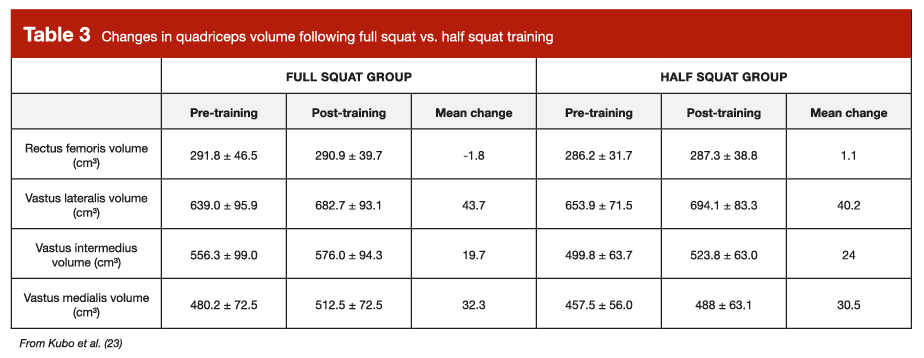
More research is required to confirm this finding, but this study at least suggests that for quad training, you may not necessarily need to train the quads through a maximal range of motion to reap all the benefits of training at long muscle lengths. For healthy people, maximum knee flexion range of motion is around 150°, but it appears that you may be able to maximize quad growth by training through ~90-100° of knee flexion.
A pair of studies examining triceps growth further reinforce this point.
We’ve already mentioned the study by Maeo and colleagues which compared the effects of pushdowns and overhead triceps extensions (through 0-90° of elbow flexion) on hypertrophy of the long head of the triceps (17). In this study, overhead triceps extensions (which trained the long head of the triceps through longer muscle lengths) resulted in more growth.
However, a separate study by Stasinaki and colleagues also compared the effects of pushdowns and overhead triceps extensions on hypertrophy of the long head of the triceps (24). However, instead of having both arms train through 0-90° of elbow flexion, this study had subjects perform overhead triceps extensions through even longer muscle lengths.
Pushdowns were performed with an elbow range of motion spanning from 10° to 90° of elbow flexion, while overhead triceps extensions were performed with an elbow range of motion spanning from 150° to 70° of elbow flexion. In other words, the arms performing pushdowns trained at muscle lengths that were comparable to the pushdown arms in the Maeo study, but the arms performing overhead triceps extensions trained at even longer muscle lengths (for the long head of the triceps) than the arms performing overhead triceps extensions in the Maeo study.
Unlike the Maeo study, the study by Stasinaki and colleagues found that overall increases in cross-sectional area for the long head of the triceps was similar following both training interventions. Overhead triceps extensions were non-significantly better for growing the distal region of the long head of the triceps (closer to the elbow), while pushdowns were non-significantly better for growing the proximal region (closer to the shoulder).
Taken together, these studies suggest that you can maximize triceps growth by training at long-but-not-extreme muscle lengths (overhead position, with up to 90° of elbow flexion), but that you achieve less growth by training through shorter muscle lengths (arms at your side, with up to 90° of elbow flexion) and even longer muscle lengths (overhead position, with up to 150° of elbow flexion).
So, at least for now, the research seems to suggest that training at longer muscle lengths tends to result in more muscle growth, but it also suggests that you shouldn’t necessarily go out of your way to train at the absolute longest muscle lengths possible. To be clear, it’s not that training at maximal muscle lengths is bad – squatting through 140° of knee flexion still caused just as much quad growth as squatting through 90° of knee flexion, and training the long head of the triceps at extreme muscle lengths did still cause as much hypertrophy as training at shorter muscle lengths – it’s just not always necessary, or even beneficial.
As a general heuristic, it’s probably not a bad idea to train through the longest ranges of motion (or through the longest muscle lengths) that are comfortable and feasible, but you also shouldn’t avoid exercises or feel like you’re wasting your time if you can’t train a particular lift through a joint’s full range of motion, or at the longest possible muscle lengths. It seems that training at pretty long muscle lengths, or through a pretty long range of motion, is probably just fine (and sometimes even preferable).
Is There Anything Special About the Hypertrophy Caused by Training at Long Muscle Lengths?
The hypertrophy induced by long muscle length training differs from the hypertrophy induced by training at shorter muscle lengths in two important ways.
First, as discussed previously, training at longer muscle lengths generally causes more hypertrophy in middle and distal regions of the muscles being trained, whereas long muscle length and short muscle length training seem to lead to similar amounts of hypertrophy in more proximal regions of muscles.
More research is needed to investigate precisely why training at long muscle lengths is particularly beneficial for increasing hypertrophy in the distal regions of muscles. However, a line of research by Wakahara and colleagues hints at one potential explanation (25, 26, 27). This line of research (intuitively) suggests that variation in intramuscular regional hypertrophy is related to variation in intramuscular regional activation. In other words, if a particular exercise robustly activates the proximal part of a muscle, but not the distal part, you’re likely to experience more hypertrophy in the proximal parts of the muscle than the distal parts of the muscle. So, it’s possible that training at short muscle lengths preferentially activates the proximal parts of muscles (leading to plenty of proximal hypertrophy, but less distal hypertrophy), whereas training at long muscle lengths activates the entire length of the muscles being trained (leading to plenty of hypertrophy in the proximal and distal regions of the muscles).
Second, training at shorter muscle lengths seems to primarily lead to hypertrophy by increasing muscle cross-sectional area, whereas training at longer muscle lengths leads to both increases in cross-sectional area and increases in muscle length.
The evidence that training at longer muscle lengths increases muscle length comes from two different sources. First, as discussed previously, resistance training (with an eccentric component) through long muscle lengths can shift the length-tension curve of muscle (4), such that the optimal length of the muscle for force output corresponds with a longer muscle length. This shift suggests the addition of sarcomeres in series. Second, training with a longer range of motion seems to increase muscle fascicle length (21, 22). Both of these findings suggest that training through long muscle lengths increases muscle fiber length (via an increase in sarcomeres in series). For more on the topic of increasing muscle length, this is an excellent review paper (28).
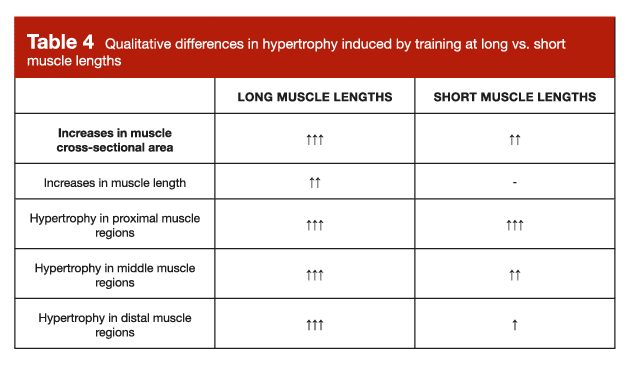
Further Evidence that Tension at Long Muscle Lengths is Particularly Beneficial for Hypertrophy
To this point, we’ve only discussed the impact of dynamic contractions through different muscle lengths or ranges of motion. However, one final line of evidence further supports the idea that training at long muscle lengths is particularly beneficial for muscle growth: research on isometric training.
A 2019 systematic review by Oranchuk and colleagues summarized the research examining the impact of isometric training on hypertrophy (29). The researchers found three studies comparing the hypertrophy effects of isometrics performed at long versus short muscle lengths. In their words, “All three studies found that isometric training at long muscle lengths (LMLs) was superior to equal volumes of training at short muscle lengths (SMLs) for increasing muscle size.”
Why Does Training at Longer Muscle Lengths Result in Greater Hypertrophy?
Before wrapping up, it’s at least worth taking a stab at attempting to explain why training at longer muscle lengths results in greater hypertrophy. And, I say “attempt” because there are a lot of potential mechanisms with some degree of support, but no single mechanism has overwhelming empirical support, or the ability to explain all of the hypertrophy research on this topic. Finally, I’ll note that I’ll be focusing on mechanisms that could explain the observed changes in muscle thickness and cross-sectional area, rather than the observed increases in muscle length.
Regional Activation?
As mentioned previously, training at long muscle lengths might lead to more hypertrophy – specifically, more hypertrophy in the distal regions of muscles – due to differences in regional muscle activation (25, 26, 27). This would be a tidy explanation for all of these findings, but it has one rather major problem: the research linking differences in regional activation to differences in regional muscle hypertrophy wasn’t carried out in the context of comparing the effects of training at long versus short muscle lengths.
In other words, we know that regional differences in activation can lead to regional differences in hypertrophy in some contexts, but we don’t yet know if long- and short-muscle-length training do actually lead to differences in regional muscle activation. So, if future research found that training at long muscle lengths does lead to greater muscle activation in the middle and distal regions of muscles (compared to training at short muscle lengths), that would provide us with a tidy explanation for most of the research on this topic. However, for now, this potential explanation should be considered extremely tentative.
Stretching as an Independent Hypertrophy Stimulus?
A handful of human studies have found that sufficiently long, sufficiently intense static stretching interventions can independently cause muscle hypertrophy (30, 31, 32; MASS Review). Furthermore, a line of animal studies involving extreme stretch stimuli (i.e. weighted stretches for a period of weeks or months) reported some of the most extreme muscle growth ever observed in a research context (33). So, is it possible that the additive effects of a stretch stimulus could explain the hypertrophy results observed in these studies?
Unfortunately, that seems unlikely. The types of stretching interventions shown to directly cause hypertrophy in humans don’t particularly resemble the type of “stretch” you experience in a normal resistance training context. These studies used static stretching interventions, at the very end of the subjects’ ranges of motion, with each stretch being held for 5-60 minutes.
Conversely, the studies supporting the idea that training at longer muscle lengths results in more hypertrophy rarely take the subjects to the very end of their range of motion. Even if these studies did push subjects to the end of their range of motion, each set would involve less than 30 seconds of end-ROM “stretching” (just a brief instant at the bottom of each rep). Furthermore, as previously discussed, there’s direct evidence that you don’t need to go to the very end of your range of motion for training at longer muscle lengths to yield greater hypertrophy (for example, the Kubo study which found that squatting through 90° of knee flexion led to just as much quad growth as squatting through 140° of knee flexion; 23). Finally, the Stasinaki study is really the only study in this area that did involve training at the end-ROM for a particular muscle (overhead triceps extensions with up to 150° of elbow flexion, which would put the long head of the triceps in a deep stretch) – it was one of the few studies finding that training at long muscle lengths didn’t lead to more muscle growth than training at shorter muscle lengths (24).
Thus, it does appear that sufficiently intense stretches, held for a sufficiently long duration, can directly contribute to hypertrophy. However, it also appears that this mechanism can’t explain the finding that training at longer muscle lengths tends to cause more muscle growth than training at shorter muscle lengths.
Of note, the phrase “stretch-mediated hypertrophy” is often used to describe the observation that training at longer muscle lengths tends to result in more hypertrophy than training at shorter muscle lengths. However, I’m not sure if “stretch-mediated hypertrophy” is actually an appropriate term to describe this phenomenon, as it’s unclear whether the increased hypertrophy observed when training at long muscle lengths is actually mediated by stretch per se.
Muscle Deoxygenation and Hypoxic Stress?
On the front end, I’ll note that I don’t think that this is a primary factor explaining why training at long muscle lengths leads to greater hypertrophy, but I do think it may contribute in some contexts.
Incidentally, the evidence supporting this tentative mechanism comes from the only study that observed substantially more hypertrophy in a group training at shorter muscle lengths (at least in terms of the maximal muscle lengths trained in both groups).
In a study by Goto and colleagues (MASS Review), one group of subjects performed lying triceps extensions through a full range of motion: from 0° to 120° of elbow flexion. Another group trained through the middle of the range of motion: from 45° to 90° of elbow flexion (34). Despite the fact that the full-ROM group trained through longer muscle lengths at the bottom of each rep than the partial-ROM group, the partial-ROM group experienced considerably more triceps growth. Furthermore, the researchers found that the triceps hypertrophy achieved by the subjects in the partial-ROM group was significantly associated with the degree of oxygen desaturation their muscles experienced during training (Figure 12).
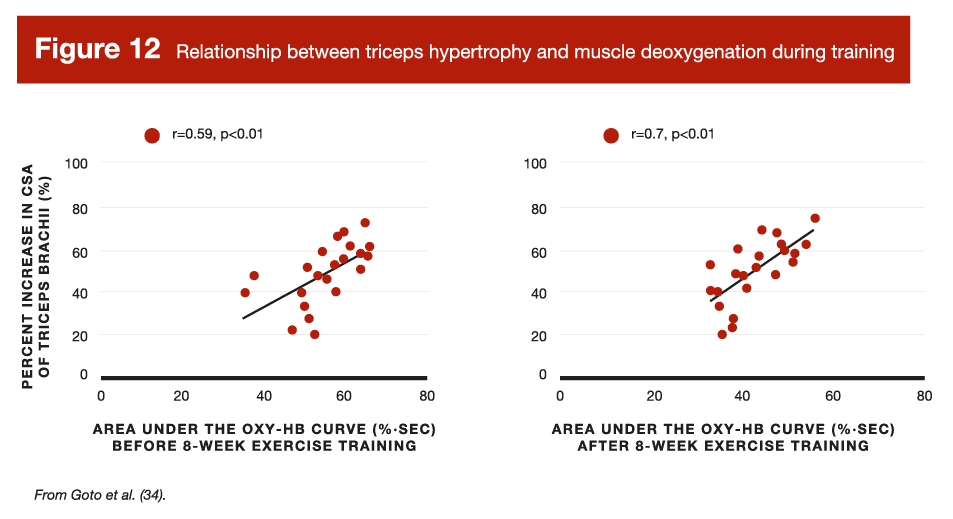
In some circumstances, this mechanism could potentially contribute to increased hypertrophy following partial-ROM training at long muscle lengths. For many exercises, when you lock out a rep, your muscles can relax a bit. When they relax, they put less pressure on the arteries carrying oxygenated blood to your muscles, and the veins removing deoxygenated blood from your muscles (35). So, for example, if you did dumbbell press through just the bottom half of the range of motion (i.e. “constant tension” training), your pecs and triceps would stay under load the entire time, potentially leading to greater muscle deoxygenation and greater hypertrophy. Furthermore, a similar mechanism may explain why subjects experienced more muscle growth in the monoarticular heads of the triceps following overhead triceps extensions (versus pushdowns) in the previously discussed study by Maeo and colleagues (17), despite the fact that overhead triceps extensions and pushdowns train the monoarticular heads of the triceps at the same muscle lengths: with the arms overhead, oxygen delivery to the active muscles would be somewhat compromised, since arterial bloodflow would be resisted by gravity (unlike when performing pushdowns). However, this tentative explanation can’t explain all (or even most) of the research findings supporting long muscle length training. Many of the studies used knee extensions, where the quads are still under load at the top of each rep (and thus, at short muscle lengths), and the muscles aren’t under load at the bottom of each rep (and thus, at long muscle lengths). Finally, I’ll also note that I’d like to see more studies verifying that muscle deoxygenation is truly a driver of hypertrophy before I’d feel particularly confident in its explanatory power.
Greater Total Muscle Tension?
Research suggests that mechanical tension is the primary initiator of muscle hypertrophy signaling (36), so it’s been (quite logically) posited that training at longer muscle lengths might lead to greater total mechanical tension than training at shorter muscle lengths, and thus lead to greater hypertrophy for completely “normal” reasons, with no additional mechanism required. In other words, if training at longer muscle lengths necessarily increases tension on the prime movers for a particular exercise, we may expect it to result in greater hypertrophy, simply due to the importance of muscular tension for hypertrophy.
In general, muscles produce the most active force when their fibers (or, more appropriately, the sarcomeres within those fibers) are at resting length (37). At resting length, the actin and myosin proteins within each sarcomere have the greatest amount of overlap, thus allowing for the largest number of force-generating crossbridges to be formed. When muscle fibers acutely shorten or lengthen, fewer actin/myosin crossbridges can form, leading to a reduction in active muscular tension (Figure 13).

However, muscles also have non-contractile elements that can contribute to passive muscular tension as the muscles lengthen. Namely, as fibers are stretched past their resting length, the passive tension can increase in the collagenous extracellular matrix of muscles (the endomysium, perimysium, and epimysium; 38), and in the giant titin proteins that run through each muscle fiber (39). So, while active mechanical tension decreases as muscle length increases, passive mechanical tension increases as muscle length increases past the fibers’ resting length (Figure 14).
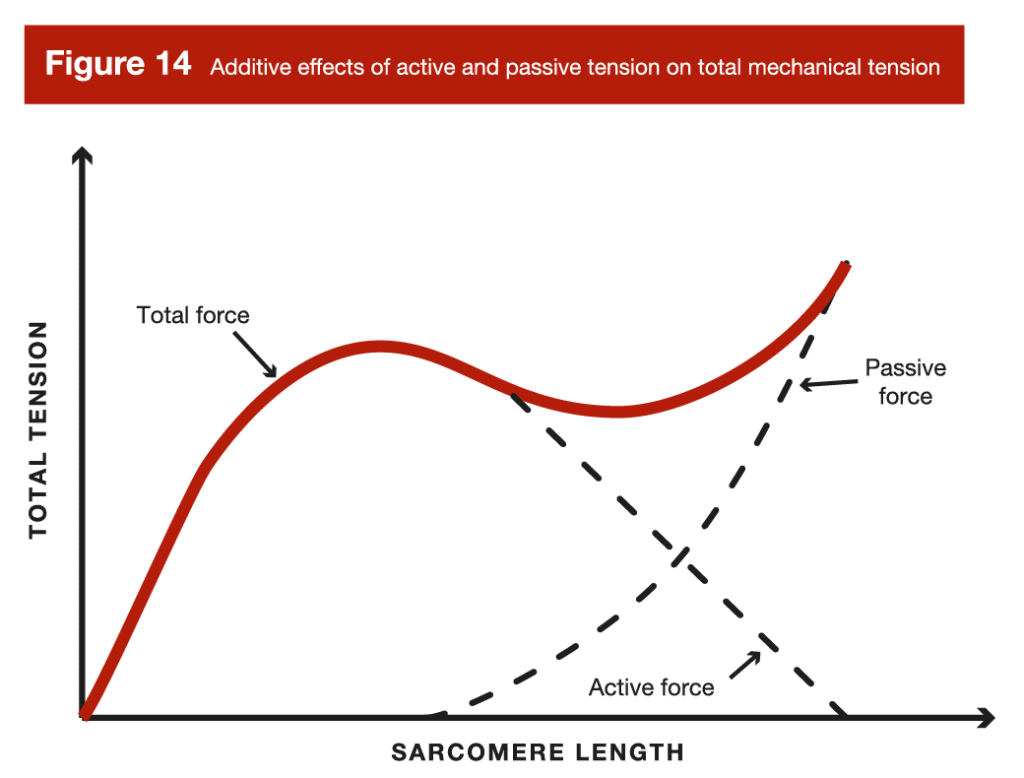
So, does the evidence suggest that these increases in passive tension are sufficient to increase total muscular tension when training at long muscle lengths?
Probably not. Or, at minimum, not always.
This is a sticky subject, in part because there aren’t a ton of studies directly quantifying muscles’ length-tension relationships in vivo, and in part because it’s challenging to differentiate the active and passive forces present even when the length-tension relationship is quantified (40).
However, we can look at torque-angle curves to get a rough idea of the amount of total tension being developed by different muscles across their full range of motion. In general, we see that muscles typically create peak levels of torque near the middle of most joint ranges of motion. For example, we observe peak knee extension torque at around 50-80° of knee flexion (Figure 15), and peak elbow flexion and extension torque at around 70-90° of elbow flexion (41). Notably, those peak torque values don’t occur near the maximal muscle lengths of the quads, biceps, and triceps (respectively).

These torque-angle curves suggest that less total tension is being developed at very long muscle lengths, but that tentative takeaway is complicated by the fact that muscle moment arms can change with changes in joint angles. For example, if joint torque is 20% lower at end-ROM than it was through the middle of the range of motion, but the muscle’s internal moment arm is 30% shorter, that would imply that total contractile forces were still higher at end-ROM, despite a decrease in torque.
If you wanted to fully model out the length-tension relationship of most major muscle groups to see if total tension does truly increase at long muscle lengths, you can be my guest. I think there’s probably enough data on torque-angle curves and muscle moment arms to keep you busy for quite a while. However, we don’t have to go quite that far to answer the question at hand.
The aforementioned study by Maeo and colleagues (17) investigating the impact of joint position on triceps hypertrophy can help us answer these questions: is total mechanical tension necessarily greater when training at longer muscle lengths? And, does training at long muscle lengths need to result in an increase in total mechanical tension in order to cause greater hypertrophy?
In this study, movement only occurred at the elbow, and both training conditions involved training the elbow through the same range of motion (0-90° of elbow flexion). Thus, this study negates concerns related to muscle moment arms, since the muscle moment arms of the triceps at the elbow would have been essentially the same in both training conditions. Furthermore, this study reported the training loads used in each condition, thus letting us know if the subjects generated more total muscular tension when training at longer or shorter muscle lengths (since both active and passive tension contribute to net tension, and thus joint torque, and thus the loads that could be used in training).
So, what did the study find? Subjects used more weight for pushdowns than overhead triceps extensions (Figure 16), but overhead triceps extensions resulted in more hypertrophy than pushdowns. Thus, total muscular tension during training was lower when training at longer muscle lengths, but training at longer muscle lengths still resulted in greater hypertrophy.
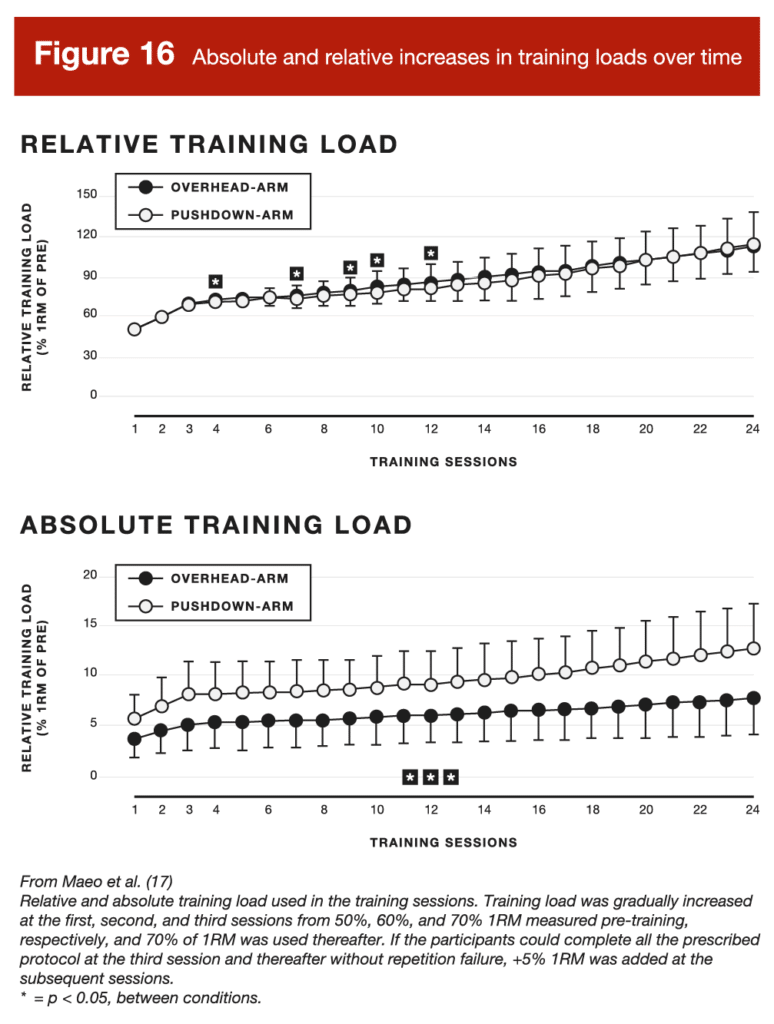
To be clear, I’m not claiming that training at longer muscle lengths never results in greater total muscular tension. For example, in the other study by Maeo and colleagues (looking at the effects of seated versus lying leg curls on hamstrings growth; 16), subjects were able to use heavier weights when training at long muscle lengths, thus suggesting that training at longer muscle lengths did result in greater total muscular tension. Furthermore, I’m also not claiming that increases in total mechanical tension aren’t beneficial for hypertrophy. However, I am claiming that training at longer muscle lengths can lead to greater hypertrophy, even when training at longer muscle lengths results in decreases in total mechanical tension.
Thus, potential increases in mechanical tension don’t seem to be the primary factor explaining the increases in hypertrophy observed when training at longer muscle lengths. Mechanical tension isn’t always higher when training at longer muscle lengths, and training at longer muscle lengths can still lead to more hypertrophy, even when training at longer muscle lengths results in decreased mechanical tension.
Additive Tension- and Fiber Length-Related Signaling Mechanisms?
As mentioned previously, mechanical tension has been identified as the primary contributor to muscle hypertrophy. However, it’s worth briefly discussing how mechanical tension eventually results in muscle growth.
In short, it’s currently believed that there are proteins on the surface of your muscle fibers (called costameres) that kick off the party (42). These proteins connect the muscle fibers to the surrounding matrix of connective tissue. When a muscle fiber contracts, the position of the fiber changes relative to the surrounding (noncontractile) connective tissue. When this occurs, the muscle fiber pulls against the connective tissue (and the connective tissue pulls against the muscle fiber) via these costameres that anchor the fiber to the connective tissue. This process creates a shearing force that these costamere proteins “feel.” In turn, costamere proteins kick off a signaling cascade that ultimately results in increased muscle protein synthesis. This whole process is referred to as “mechanotransduction.”
Thus, it’s believed that the primary pathway that turns mechanical tension into a stimulus for hypertrophy ultimately starts with proteins on the surface of the muscle fiber (36).
However, there are also proteins inside muscle fibers that are sensitive to tension and changes in fiber length. The most notable of these proteins is called titin (as a fun piece of trivia, titin is the largest protein in the human body). There’s growing evidence that titin also has mechanosensitive signaling functions (similar to those anchor proteins on the surface of muscle fibers) that are sensitive to increases in both fiber length and fiber tension – which sounds a lot like resistance training at long muscle lengths. The net result of this signaling cascade is thought to be both increases in fiber length and fiber cross-sectional area – which sounds a lot like the adaptations observed following resistance training at long muscle lengths (43, 44, 45).
In short, it’s possible that “normal” mechanical tension is primarily just sensed by costameres, resulting in elevated muscle protein synthesis and muscle hypertrophy, whereas mechanical tension at relatively long muscle lengths is sensed by both costameres and titin, resulting in even larger elevations in muscle protein synthesis and even greater hypertrophy.
This would certainly be an elegant explanation to explain why training at longer muscle lengths generally results in more hypertrophy. And, ultimately, I think it’s the most likely primary explanation. However, there are still quite a few missing puzzle pieces that need to be filled in before I’d be confident that titin-associated signaling is truly the primary explanation for these findings.
First, we need studies that measure titin kinase phosphorylation following long- and short-muscle-length training. Second, we’d need follow-up studies showing that titin kinase phosphorylation was both a) associated with hypertrophy in general and b) associated with the presence of within-subject hypertrophy differences following long- and short-muscle length training. Finally, we’d need studies examining the muscle lengths at which titin kinase phosphorylation occurs.
“Other”
This section focused on potential mechanisms that fall into one of three categories:
- Mechanisms that seem like the most plausible potential explanations for the observation that training at long muscle lengths results in more muscle growth (regional activation, titin-associated signaling).
- Mechanisms that may potentially explain some of the individual findings, but seem insufficient to adequately explain the broader phenomenon (hypoxic stress).
- Mechanisms that seem unlikely to explain the broader phenomenon, but that warranted mention due to how frequently they’re invoked as potential explanatory factors (increased total tension due to increased passive tension, and stretch per se as an independent contributor).
However, this section isn’t meant to be completely exhaustive. There’s another category of potential mechanisms that don’t warrant an in-depth discussion, because they’re not often invoked to explain the superiority of long muscle length training, and they either seem unlikely to be primary drivers of the phenomenon, or they lack sufficient research for a thorough evaluation.
For example, eccentric stress through longer muscle lengths generally causes more muscle damage than eccentric stress through shorter muscle lengths (46). The current balance of evidence suggests that muscle damage likely isn’t a primary mediator of hypertrophy (36), but it hasn’t been fully disproven as a potential secondary mechanism. So, I don’t think it’s worth fully exploring the links between range of motion and muscle damage, and between muscle damage and hypertrophy. However, it’s not totally inconceivable that muscle damage could partially explain the benefits of long muscle length training in some contexts.
Furthermore, the effects of exercise range of motion on blood lactate levels are largely unexplored, but it’s likely that training through a longer range of motion or at longer muscle lengths would lead to a larger lactate response (due to higher levels of mechanical work per rep or due to increased vascular occlusion). There’s some indication that intramuscular lactate enhances hypertrophy signaling at sufficient concentrations (though the evidence is stronger in mice than humans; 47). So, at the moment, potential effects on lactate (and potential effects of lactate) seem unlikely to explain the hypertrophy effects of training at longer muscle lengths, but lactate-related effects can’t be fully ruled out until there’s more human research on the topic.
Similarly, some hormonal factors may (in part) contribute to the effects of training at long muscle lengths. For example, training at longer muscle lengths seems to increase IGF-1 levels to a greater extent than training at shorter muscle lengths (48), and IGF-1 is an important regulator of muscle hypertrophy and atrophy (49). To be clear, I’m certainly not proposing that the observed effects on IGF-1 could independently explain the hypertrophy findings within the body of literature, but the impact of range of motion and training at long versus short muscle lengths on hormonal responses (particularly autocrine and paracrine hormonal responses) is almost entirely unexplored.
Finally, there are plenty of other factors related to hypertrophy – capillary density (50, 51), satellite cell responses and myonuclear accretion (52), androgen receptor density (53), ribosome biogenesis (54), and probably a dozen others. Currently, we simply don’t know whether training at longer muscle lengths influences or interacts with these other factors to influence muscle growth, because those interactions haven’t been studied.
Ultimately, this line of research is still just scratching the surface, and I’d be quite surprised if we found out that training through longer muscle lengths leads to more muscle growth due to precisely one causative mechanism.
This Stuff is Messy
Before discussing practical applications and wrapping up, it’s worth simply acknowledging that this body of research is very interesting if you either a) want to get jacked or b) enjoy muscle physiology. Part of the reason it’s so interesting is that it hints at new frontiers in our understanding of muscle hypertrophy. We have an intervention (training at longer muscle lengths) that leads to more hypertrophy and we’re not entirely sure why. Unsolved mysteries are inherently tantalizing, and solving this mystery could teach us interesting new things about how to make hypertrophy training even more effective.
With that in mind, we’d just like to push back against a common impulse that seems to be going around. On social media, and across various blogs, plenty of people are acting like this is already a fully solved problem: we already know why training at longer muscle lengths produces more muscle growth.
Their explanations tend to reduce everything to total mechanical tension. Training at “long muscle lengths” means performing an exercise through a range of motion that stretches your sarcomeres beyond resting length (i.e., through a range of motion that progresses past the plateau of the active length-tension curve, down onto the descending limb of the length-tension curve). When you do so, passive tension will increase, resulting in more total mechanical tension, and thus more muscle hypertrophy.
The problem with this explanation is that it’s simply wrong at worst, or incomplete at best. As discussed previously, training at longer muscle lengths can lead to greater hypertrophy even when training at longer muscle lengths results in lower total tension.
Furthermore, we also have evidence that long(er) muscle length training can result in greater hypertrophy, even when the long(er) muscle length training occurs at muscle lengths that are on the ascending limb of the active length-tension curve. For example, it seems that your biceps really don’t extend much (if any) past “resting length” when your arms are at your side (55). In other words, when your arms are fully extended, the sarcomeres of your biceps are at or near the plateau region of the length-tension relationship. When you’re in a bit of shoulder flexion (as you would be when performing a preacher curl, for example), the biceps would be at even shorter relative muscle lengths. However, a 2021 study by Sato and colleagues (56; MASS Review) found that training the biceps through long(er) muscle lengths (preacher curls from 0° to 50° of elbow flexion) led to more muscle growth than training the biceps through short muscle lengths (preacher curls from 80° to 130° of elbow flexion). In fact, there was a ~2.6-fold difference in hypertrophy between conditions (8.9 ± 3.9% versus 3.4 ± 2.7%).
Going beyond general mechanistic explanations, muscle lengths and passive tension can vary considerably between muscles and between individuals to an extent that (I suspect) most people don’t realize. For example, it’s commonly assumed that passive tension only starts increasing when sarcomeres are stretched beyond their optimal length for active force generation. However, that’s not always true. Sometimes, passive tension starts increasing when sarcomeres are still on the ascending limb of the length-tension curve. Sometimes, passive tension doesn’t start increasing until sarcomeres are stretched far past optimal length (59). Furthermore, the optimal length of sarcomeres can occur at different joint angles for the same muscle between individuals. For example, a 2010 study by Winter and Challis analyzing the rectus femoris and gastrocnemius found that the joint angles corresponding to the ascending limb of the length-tension curve for some subjects corresponded to the descending limb of the length-tension curve for other subjects (57).
In short, this perspective (that the effects of training at long muscle lengths are explained solely by increases in total mechanical tension) seems to be predicated upon several assumptions that are not always true:
- Passive tension cannot be generated when sarcomeres are on the ascending limb of the length/tension curve.
- Passive tension reliably starts increasing at the instant that sarcomeres enter the descending limb of the length/tension curve.
- Total tension (summed active and passive tension) is reliably higher all along the descending limb of the length/tension curve than the plateau region.
- Training at longer muscle lengths results in more muscle growth if and only if training at longer muscle lengths results in greater total mechanical tension.
- Training at longer muscle lengths results in greater hypertrophy if and only if those longer muscle lengths coincide with the descending limb of the sarcomere length/tension curve.
If someone looks at this body of research and thinks they have everything figured out, we’d simply encourage them to soften their biases and take another look. It’s very satisfying to feel like you can fully understand and explain a wide array of complex phenomena by understanding a single mechanism (in this case, positing that muscle hypertrophy can be fully reduced to a function of mechanical tension), but we’d caution against giving into the allure of reductionism. If muscle hypertrophy really was that simple, it would have been a fully solved problem ages ago. When hundreds of scientists are still searching for answers, it seems quite unlikely that there is a single, simple explanation that has eluded all of them.
We know a lot more about how muscle length and range of motion impact hypertrophy than we knew a few years ago, but there’s still a lot left to learn. Every new answer leaves us with several new questions. However, pushing forward and learning more about this topic promises to teach us exciting new things about how muscles adapt to training, and more importantly, how we can train more effectively.
Practical Recommendations
For People With Strength or Performance Goals
For most people, most of the time, the principle of specificity applies: primarily train using the range(s) of motion you’d most like to build strength through.
There are three potential exceptions to this general principle:
- If you’re relatively new to resistance training, and your primary goal is to build strength through a partial range of motion, it may still behoove you to do most of your training through a full range of motion.
- If your primary goal is to build strength through a partial range of motion coinciding with short muscle lengths, but you would also benefit from adding more muscle to your frame, it may still be a good idea to do the bulk of your training through a full range of motion (at least when you don’t have a competition on the immediate horizon).
- If your primary goal is to build strength through a full range of motion, you may still benefit from mixing in some partial-ROM training.
For People With Hypertrophy Goals
As a general heuristic, you should perform most exercises through the longest range of motion you (safely and comfortably) can.
If you want to take things one step further, you could specifically seek out exercises that let you train your target muscle(s) though the longest possible (safe and comfortable) muscle lengths. Make sure these exercises are still challenging when your muscles are in a lengthened position.
If you want to take things an additional step further, you could eschew the portion of the range of motion that trains your muscles at short muscle lengths, and give long-muscle-length partials a shot. Pausing reps when your muscles are in a lengthened position will ramp the challenge up further.
If you’re feeling really experimental, you could even give long-muscle-length isometrics a shot, holding each isometric rep for 20-60 seconds, at the longest muscle length that still allows for active force generation.
For Everyone
As a final note, you don’t need to get super obsessive or neurotic about range of motion or training at long muscle lengths. Plenty of people have gotten strong and jacked by training through all sorts of ranges of motion. And, as discussed previously, training at the longest possible muscle lengths may not always be superior to training at pretty-long-but-not-quite-maximal muscle lengths. When the resistance training community takes a particular interest in a particular training variable, there’s a tendency for some folks to take things a bit too far. There’s also a tendency for content creators to make more and more extreme content around the hot topic, because the most extreme views tend to garner the most attention.
A few years back, training frequency was hot. “It may be better to train muscles 2-3 times per week instead of just once per week” turned into “natural lifters can’t build muscle or get stronger training each muscle just once per week, and you should really be training every muscle at least four times per week if you’re serious about your gains.” More recently, autoregulation was hot. “It may not be the best idea to train to failure all the time, and it may be beneficial to roughly quantify your proximity to failure” turned into, “if you don’t master the RPE scale and always leave 2-4 reps in reserve, you’ll overtrain, burn out, and be small and weak forever. Also, it’s literally impossible to recover from training to failure.” Similar dynamics have played out with training volume, accommodating resistance, and probably a half dozen other factors.
Already, I’ve seen some incredibly spicy (and completely unjustifiable) takes related to range of motion and long-muscle-length training. For example, “bench press doesn’t build your pecs because it doesn’t actually train your pecs through the longest possible muscle lengths,” and, “split squats won’t build your quads or glutes, because they don’t allow you to train through a maximal knee or hip range of motion.” Do not use this article to support that type of position. If you do, that means you didn’t read to the end (i.e., you didn’t make it to this sentence), and you don’t actually understand this area of research.
We do know that training at longer muscle lengths tends to build more muscle than training at shorter muscle lengths, but…
- That doesn’t imply that the compound exercises people have been successfully using for decades are suddenly ineffective because they don’t load every muscle through the longest conceivable muscle length.
- That doesn’t imply that you can’t build muscle without access to fancy equipment that allows you to place maximal tension on a muscle in its most stretched position.
- That doesn’t necessarily imply that training through a longer range of motion or at longer muscle lengths is always superior (as discussed in detail previously).
- That doesn’t imply that you should remove every exercise from your training routine that doesn’t load your muscles through the longest possible muscle lengths.
- That doesn’t imply that you should perform exercises in ways that are dangerous or painful just so you can train at slightly longer muscle lengths (for example, if your knees or hips bother you when squatting ass-to-grass, it’s perfectly fine to squat to parallel; if it hurts your shoulders to do really deep pec flyes, it’s perfectly fine to not let the dumbbells or cable handles sink quite as deep).
- That absolutely doesn’t mean you can’t build muscle unless you train through the longest possible muscle lengths all the time for every muscle, nor does it imply that training through short muscle lengths doesn’t also build muscle.
So, if you’re aiming to maximize muscle growth, it’s probably not a bad idea to train through the longest muscle lengths you (safely and comfortably) can, most of the time. But don’t be an extremist about it, especially since there’s still so much left to learn.
Get more articles like this
This article was the cover story for the November 2022 issue of MASS Research Review. If you’d like to read the full, 160-page September issue (and dive into the MASS archives), you can subscribe to MASS here.
Subscribers get a new edition of MASS each month. Each edition is available on our member website as well as in a beautiful, magazine-style PDF and contains at least 5 full-length articles (like this one), 2 videos, and 8 Research Brief articles.
Subscribing is also a great way to support the work we do here on Stronger By Science.
References
- Wolf M, Androulakis-Korakakis P, Fisher JP, Schoenfeld BJ, Steel J. Partial vs full range of motion resistance training: A systematic review and meta-analysis. SportRxiv Preprints. (2022)
- Taber CB, Vigotsky A, Nuckols G, Haun CT. Exercise-Induced Myofibrillar Hypertrophy is a Contributory Cause of Gains in Muscle Strength. Sports Med. 2019 Jul;49(7):993-997. doi: 10.1007/s40279-019-01107-8. PMID: 31016546.
- Ahtiainen JP, Walker S, Peltonen H, Holviala J, Sillanpää E, Karavirta L, Sallinen J, Mikkola J, Valkeinen H, Mero A, Hulmi JJ, Häkkinen K. Heterogeneity in resistance training-induced muscle strength and mass responses in men and women of different ages. Age (Dordr). 2016 Feb;38(1):10. doi: 10.1007/s11357-015-9870-1. Epub 2016 Jan 15. PMID: 26767377; PMCID: PMC5005877.
- Brughelli M, Cronin J. Altering the length-tension relationship with eccentric exercise : implications for performance and injury. Sports Med. 2007;37(9):807-26. doi: 10.2165/00007256-200737090-00004. PMID: 17722950.
- Bloomquist K, Langberg H, Karlsen S, Madsgaard S, Boesen M, Raastad T. Effect of range of motion in heavy load squatting on muscle and tendon adaptations. Eur J Appl Physiol. 2013 Aug;113(8):2133-42. doi: 10.1007/s00421-013-2642-7. Epub 2013 Apr 20. PMID: 23604798.
- Rhea M, Kenn J, Peterson M, et al. Joint-angle specific strength adaptations influence improvements in power in highly trained athletes. Human Movement. 2016;17(1):43-49. doi:10.1515/humo-2016-0006.
- Martínez-Cava A, Hernández-Belmonte A, Courel-Ibáñez J, Morán-Navarro R, González-Badillo JJ, Pallarés JG. Bench Press at Full Range of Motion Produces Greater Neuromuscular Adaptations Than Partial Executions After Prolonged Resistance Training. J Strength Cond Res. 2022 Jan 1;36(1):10-15. doi: 10.1519/JSC.0000000000003391. PMID: 31567719.
- Hyldahl RD, Nelson B, Xin L, Welling T, Groscost L, Hubal MJ, Chipkin S, Clarkson PM, Parcell AC. Extracellular matrix remodeling and its contribution to protective adaptation following lengthening contractions in human muscle. FASEB J. 2015 Jul;29(7):2894-904. doi: 10.1096/fj.14-266668. Epub 2015 Mar 25. PMID: 25808538.
- Franchi MV, Reeves ND, Narici MV. Skeletal Muscle Remodeling in Response to Eccentric vs. Concentric Loading: Morphological, Molecular, and Metabolic Adaptations. Front Physiol. 2017 Jul 4;8:447. doi: 10.3389/fphys.2017.00447. PMID: 28725197; PMCID: PMC5495834.
- Bazyler CD, Sato K, Wassinger CA, Lamont HS, Stone MH. The efficacy of incorporating partial squats in maximal strength training. J Strength Cond Res. 2014 Nov;28(11):3024-32. doi: 10.1519/JSC.0000000000000465. PMID: 24662234.
- Gillingham B, DeBeliso M. The Efficacy of Partial Range of Motion Deadlift Training: A Pilot Study. International Journal of Sports Science. Vol. 12 No. 1, 2022, pp. 14-22. doi: 10.5923/j.sports.20221201.03.
- Pedrosa GF, Lima FV, Schoenfeld BJ, Lacerda LT, Simões MG, Pereira MR, Diniz RCR, Chagas MH. Partial range of motion training elicits favorable improvements in muscular adaptations when carried out at long muscle lengths. Eur J Sport Sci. 2022 Aug;22(8):1250-1260. doi: 10.1080/17461391.2021.1927199. Epub 2021 May 23. PMID: 33977835.
- Whaley O, Larson A, DeBeliso M. Progressive movement training: an analysis of its effects on muscular strength and power development. The Sport Journal. 2020
- Chua LK, Dimapilis MK, Iwatsuki T, Abdollahipour R, Lewthwaite R, Wulf G. Practice variability promotes an external focus of attention and enhances motor skill learning. Hum Mov Sci. 2019 Apr;64:307-319. doi: 10.1016/j.humov.2019.02.015. Epub 2019 Mar 1. PMID: 30831389.
- Fonseca RM, Roschel H, Tricoli V, de Souza EO, Wilson JM, Laurentino GC, Aihara AY, de Souza Leão AR, Ugrinowitsch C. Changes in exercises are more effective than in loading schemes to improve muscle strength. J Strength Cond Res. 2014 Nov;28(11):3085-92. doi: 10.1519/JSC.0000000000000539. PMID: 24832974.
- Maeo S, Huang M, Wu Y, Sakurai H, Kusagawa Y, Sugiyama T, Kanehisa H, Isaka T. Greater Hamstrings Muscle Hypertrophy but Similar Damage Protection after Training at Long versus Short Muscle Lengths. Med Sci Sports Exerc. 2021 Apr 1;53(4):825-837. doi: 10.1249/MSS.0000000000002523. PMID: 33009197; PMCID: PMC7969179.
- Maeo S, Wu Y, Huang M, Sakurai H, Kusagawa Y, Sugiyama T, Kanehisa H, Isaka T. Triceps brachii hypertrophy is substantially greater after elbow extension training performed in the overhead versus neutral arm position. Eur J Sport Sci. 2022 Aug 11:1-11. doi: 10.1080/17461391.2022.2100279. Epub ahead of print. PMID: 35819335.
- Nunes JP, Jacinto JL, Ribeiro AS, Mayhew JL, Nakamura M, Capel DMG, Santos LR, Santos L, Cyrino ES, Aguiar AF. Placing Greater Torque at Shorter or Longer Muscle Lengths? Effects of Cable vs. Barbell Preacher Curl Training on Muscular Strength and Hypertrophy in Young Adults. Int J Environ Res Public Health. 2020 Aug 13;17(16):5859. doi: 10.3390/ijerph17165859. PMID: 32823490; PMCID: PMC7460162.
- Diniz RCR, Tourino FD, Lacerda LT, Martins-Costa HC, Lanza MB, Lima FV, Chagas MH. Does the Muscle Action Duration Induce Different Regional Muscle Hypertrophy in Matched Resistance Training Protocols? J Strength Cond Res. 2022 Sep 1;36(9):2371-2380. doi: 10.1519/JSC.0000000000003883. Epub 2020 Dec 9. PMID: 33306588.
- Moreno-Villanueva AMD, Pino-Ortega J, Rico-González M. Effect of Repetition Duration—Total and in Different Muscle Actions—On the Development of Strength, Power, and Muscle Hypertrophy: A Systematic Review. Strength and Conditioning Journal: October 2022 – Volume 44 – Issue 5 – p 39-56 doi: 10.1519/SSC.0000000000000695
- McMahon GE, Morse CI, Burden A, Winwood K, Onambélé GL. Impact of range of motion during ecologically valid resistance training protocols on muscle size, subcutaneous fat, and strength. J Strength Cond Res. 2014 Jan;28(1):245-55. doi: 10.1519/JSC.0b013e318297143a. PMID: 23629583.
- Valamatos MJ, Tavares F, Santos RM, Veloso AP, Mil-Homens P. Influence of full range of motion vs. equalized partial range of motion training on muscle architecture and mechanical properties. Eur J Appl Physiol. 2018 Sep;118(9):1969-1983. doi: 10.1007/s00421-018-3932-x. Epub 2018 Jul 7. PMID: 29982844.
- Kubo K, Ikebukuro T, Yata H. Effects of squat training with different depths on lower limb muscle volumes. Eur J Appl Physiol. 2019 Sep;119(9):1933-1942. doi: 10.1007/s00421-019-04181-y. Epub 2019 Jun 22. PMID: 31230110.
- Stasinaki A-N, Zaras N, Methenitis S, Tsitkanou S, Krase A, Kavvoura A, Terzis G. Triceps Brachii Muscle Strength and Architectural Adaptations with Resistance Training Exercises at Short or Long Fascicle Length. Journal of Functional Morphology and Kinesiology. 2018; 3(2):28. https://doi.org/10.3390/jfmk3020028
- Wakahara T, Miyamoto N, Sugisaki N, Murata K, Kanehisa H, Kawakami Y, Fukunaga T, Yanai T. Association between regional differences in muscle activation in one session of resistance exercise and in muscle hypertrophy after resistance training. Eur J Appl Physiol. 2012 Apr;112(4):1569-76. doi: 10.1007/s00421-011-2121-y. Epub 2011 Aug 21. PMID: 21858666.
- Wakahara T, Ema R, Miyamoto N, Kawakami Y. Inter- and intramuscular differences in training-induced hypertrophy of the quadriceps femoris: association with muscle activation during the first training session. Clin Physiol Funct Imaging. 2017 Jul;37(4):405-412. doi: 10.1111/cpf.12318. Epub 2015 Nov 17. PMID: 26576937.
- Wakahara T, Fukutani A, Kawakami Y, Yanai T. Nonuniform muscle hypertrophy: its relation to muscle activation in training session. Med Sci Sports Exerc. 2013 Nov;45(11):2158-65. doi: 10.1249/MSS.0b013e3182995349. PMID: 23657165.
- Kruse A, Rivares C, Weide G, Tilp M, Jaspers RT. Stimuli for Adaptations in Muscle Length and the Length Range of Active Force Exertion-A Narrative Review. Front Physiol. 2021 Oct 8;12:742034. doi: 10.3389/fphys.2021.742034. PMID: 34690815; PMCID: PMC8531727.
- Oranchuk DJ, Storey AG, Nelson AR, Cronin JB. Isometric training and long-term adaptations: Effects of muscle length, intensity, and intent: A systematic review. Scand J Med Sci Sports. 2019 Apr;29(4):484-503. doi: 10.1111/sms.13375. Epub 2019 Jan 13. PMID: 30580468.
- Warneke K, Brinkmann A, Hillebrecht M, Schiemann S. Influence of Long-Lasting Static Stretching on Maximal Strength, Muscle Thickness and Flexibility. Front Physiol. 2022 May 25;13:878955. doi: 10.3389/fphys.2022.878955. PMID: 35694390; PMCID: PMC9174468.
- Panidi I, Bogdanis GC, Terzis G, Donti A, Konrad A, Gaspari V, Donti O. Muscle Architectural and Functional Adaptations Following 12-Weeks of Stretching in Adolescent Female Athletes. Front Physiol. 2021 Jul 16;12:701338. doi: 10.3389/fphys.2021.701338. PMID: 34335307; PMCID: PMC8322691.
- Simpson CL, Kim BDH, Bourcet MR, Jones GR, Jakobi JM. Stretch training induces unequal adaptation in muscle fascicles and thickness in medial and lateral gastrocnemii. Scand J Med Sci Sports. 2017 Dec;27(12):1597-1604. doi: 10.1111/sms.12822. Epub 2017 Jan 30. PMID: 28138986.
- Antonio J, Gonyea WJ. Skeletal muscle fiber hyperplasia. Med Sci Sports Exerc. 1993 Dec;25(12):1333-45. PMID: 8107539.
- Goto M, Maeda C, Hirayama T, Terada S, Nirengi S, Kurosawa Y, Nagano A, Hamaoka T. Partial Range of Motion Exercise Is Effective for Facilitating Muscle Hypertrophy and Function Through Sustained Intramuscular Hypoxia in Young Trained Men. J Strength Cond Res. 2019 May;33(5):1286-1294. doi: 10.1519/JSC.0000000000002051. PMID: 31034463.
- Hunter SK. Sex differences in human fatigability: mechanisms and insight to physiological responses. Acta Physiol (Oxf). 2014 Apr;210(4):768-89. doi: 10.1111/apha.12234. Epub 2014 Feb 25. PMID: 24433272; PMCID: PMC4111134.
- Wackerhage H, Schoenfeld BJ, Hamilton DL, Lehti M, Hulmi JJ. Stimuli and sensors that initiate skeletal muscle hypertrophy following resistance exercise. J Appl Physiol (1985). 2019 Jan 1;126(1):30-43. doi: 10.1152/japplphysiol.00685.2018. Epub 2018 Oct 18. PMID: 30335577.
- Lieber RL, Roberts TJ, Blemker SS, Lee SSM, Herzog W. Skeletal muscle mechanics, energetics and plasticity. J Neuroeng Rehabil. 2017 Oct 23;14(1):108. doi: 10.1186/s12984-017-0318-y. PMID: 29058612; PMCID: PMC5651624.
- Marcucci L, Bondì M, Randazzo G, Reggiani C, Natali AN, Pavan PG. Fibre and extracellular matrix contributions to passive forces in human skeletal muscles: An experimental based constitutive law for numerical modelling of the passive element in the classical Hill-type three element model. PLoS One. 2019 Nov 5;14(11):e0224232. doi: 10.1371/journal.pone.0224232. PMID: 31689322; PMCID: PMC6830811.
- Linke WA. Titin Gene and Protein Functions in Passive and Active Muscle. Annu Rev Physiol. 2018 Feb 10;80:389-411. doi: 10.1146/annurev-physiol-021317-121234. Epub 2017 Nov 13. PMID: 29131758.
- MacIntosh BR. Recent developments in understanding the length dependence of contractile response of skeletal muscle. Eur J Appl Physiol. 2017 Jun;117(6):1059-1071. doi: 10.1007/s00421-017-3591-3. Epub 2017 Mar 27. PMID: 28349260.
- Knapik JJ, Wright JE, Mawdsley RH, Braun J. Isometric, isotonic, and isokinetic torque variations in four muscle groups through a range of joint motion. Phys Ther. 1983 Jun;63(6):938-47. doi: 10.1093/ptj/63.6.938. PMID: 6856681.
- Li R, Narici MV, Erskine RM, Seynnes OR, Rittweger J, Pišot R, Šimunič B, Flück M. Costamere remodeling with muscle loading and unloading in healthy young men. J Anat. 2013 Nov;223(5):525-36. doi: 10.1111/joa.12101. Epub 2013 Sep 8. PMID: 24010829; PMCID: PMC3916893.
- Gautel M. Cytoskeletal protein kinases: titin and its relations in mechanosensing. Pflugers Arch. 2011 Jul;462(1):119-34. doi: 10.1007/s00424-011-0946-1. Epub 2011 Mar 18. PMID: 21416260; PMCID: PMC3114093.
- Brynnel A, Hernandez Y, Kiss B, Lindqvist J, Adler M, Kolb J, van der Pijl R, Gohlke J, Strom J, Smith J, Ottenheijm C, Granzier HL. Downsizing the molecular spring of the giant protein titin reveals that skeletal muscle titin determines passive stiffness and drives longitudinal hypertrophy. Elife. 2018 Dec 19;7:e40532. doi: 10.7554/eLife.40532. PMID: 30565562; PMCID: PMC6300359.
- Ibata N, Terentjev EM. Why exercise builds muscles: titin mechanosensing controls skeletal muscle growth under load. Biophys J. 2021 Sep 7;120(17):3649-3663. doi: 10.1016/j.bpj.2021.07.023. Epub 2021 Aug 10. PMID: 34389312; PMCID: PMC8456289.
- Baroni BM, Pompermayer MG, Cini A, Peruzzolo AS, Radaelli R, Brusco CM, Pinto RS. Full Range of Motion Induces Greater Muscle Damage Than Partial Range of Motion in Elbow Flexion Exercise With Free Weights. J Strength Cond Res. 2017 Aug;31(8):2223-2230. doi: 10.1519/JSC.0000000000001562. PMID: 27398917.
- Lawson D, Vann C, Schoenfeld BJ, Haun C. Beyond Mechanical Tension: A Review of Resistance Exercise-Induced Lactate Responses & Muscle Hypertrophy. Journal of Functional Morphology and Kinesiology. 2022; 7(4):81. https://doi.org/10.3390/jfmk7040081
- McMahon G, Morse CI, Burden A, Winwood K, Onambélé GL. Muscular adaptations and insulin-like growth factor-1 responses to resistance training are stretch-mediated. Muscle Nerve. 2014 Jan;49(1):108-19. doi: 10.1002/mus.23884. PMID: 23625461.
- Yoshida T, Delafontaine P. Mechanisms of IGF-1-Mediated Regulation of Skeletal Muscle Hypertrophy and Atrophy. Cells. 2020 Aug 26;9(9):1970. doi: 10.3390/cells9091970. PMID: 32858949; PMCID: PMC7564605.
- Snijders T, Nederveen JP, Joanisse S, Leenders M, Verdijk LB, van Loon LJ, Parise G. Muscle fibre capillarization is a critical factor in muscle fibre hypertrophy during resistance exercise training in older men. J Cachexia Sarcopenia Muscle. 2017 Apr;8(2):267-276. doi: 10.1002/jcsm.12137. Epub 2016 Aug 4. PMID: 27897408; PMCID: PMC5377411.
- Thomas ACQ, Brown A, Hatt AA, Manta K, Costa-Parke A, Kamal M, Joanisse S, McGlory C, Phillips SM, Kumbhare D, Parise G. Short-term aerobic conditioning prior to resistance training augments muscle hypertrophy and satellite cell content in healthy young men and women. FASEB J. 2022 Sep;36(9):e22500. doi: 10.1096/fj.202200398RR. PMID: 35971745.
- Petrella JK, Kim JS, Mayhew DL, Cross JM, Bamman MM. Potent myofiber hypertrophy during resistance training in humans is associated with satellite cell-mediated myonuclear addition: a cluster analysis. J Appl Physiol (1985). 2008 Jun;104(6):1736-42. doi: 10.1152/japplphysiol.01215.2007. Epub 2008 Apr 24. PMID: 18436694.
- Morton RW, Sato K, Gallaugher MPB, Oikawa SY, McNicholas PD, Fujita S, Phillips SM. Muscle Androgen Receptor Content but Not Systemic Hormones Is Associated With Resistance Training-Induced Skeletal Muscle Hypertrophy in Healthy, Young Men. Front Physiol. 2018 Oct 9;9:1373. doi: 10.3389/fphys.2018.01373. PMID: 30356739; PMCID: PMC6189473.
- Roberts MD, Haun CT, Mobley CB, Mumford PW, Romero MA, Roberson PA, Vann CG, McCarthy JJ. Physiological Differences Between Low Versus High Skeletal Muscle Hypertrophic Responders to Resistance Exercise Training: Current Perspectives and Future Research Directions. Front Physiol. 2018 Jul 4;9:834. doi: 10.3389/fphys.2018.00834. PMID: 30022953; PMCID: PMC6039846.
- Murray WM, Buchanan TS, Delp SL. The isometric functional capacity of muscles that cross the elbow. J Biomech. 2000 Aug;33(8):943-52. doi: 10.1016/s0021-9290(00)00051-8. PMID: 10828324.
- Sato S, Yoshida R, Kiyono R, Yahata K, Yasaka K, Nunes JP, Nosaka K, Nakamura M. Elbow Joint Angles in Elbow Flexor Unilateral Resistance Exercise Training Determine Its Effects on Muscle Strength and Thickness of Trained and Non-trained Arms. Front Physiol. 2021 Sep 16;12:734509. doi: 10.3389/fphys.2021.734509. PMID: 34616309; PMCID: PMC8489980.
- Winter SL, Challis JH. The force-length curves of the human rectus femoris and gastrocnemius muscles in vivo. J Appl Biomech. 2010 Feb;26(1):45-51. doi: 10.1123/jab.26.1.45. PMID: 20147757.
- Pallarés JG, Cava AM, Courel-Ibáñez J, González-Badillo JJ, Morán-Navarro R. Full squat produces greater neuromuscular and functional adaptations and lower pain than partial squats after prolonged resistance training. Eur J Sport Sci. 2020 Feb;20(1):115-124. doi: 10.1080/17461391.2019.1612952. Epub 2019 May 15. PMID: 31092132.
- Lieber RL, Binder-Markey BI. Biochemical and structural basis of the passive mechanical properties of whole skeletal muscle. J Physiol. 2021 Aug;599(16):3809-3823. doi: 10.1113/JP280867. Epub 2021 Jul 6. PMID: 34101193; PMCID: PMC8364503.

